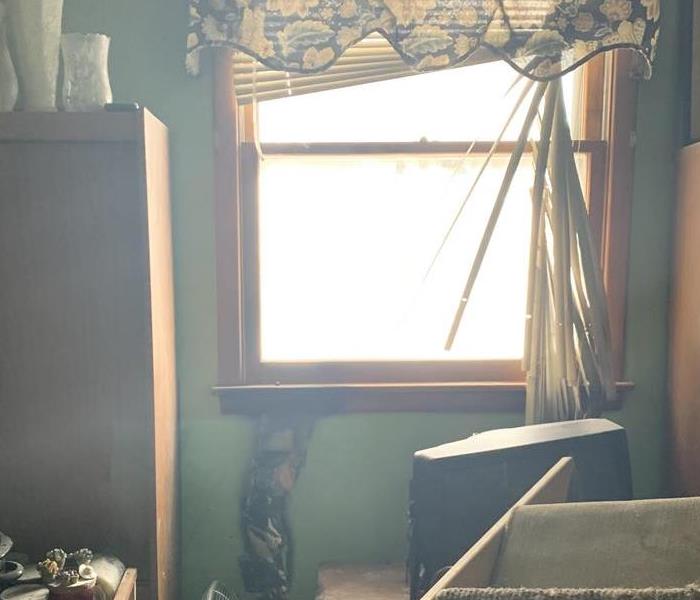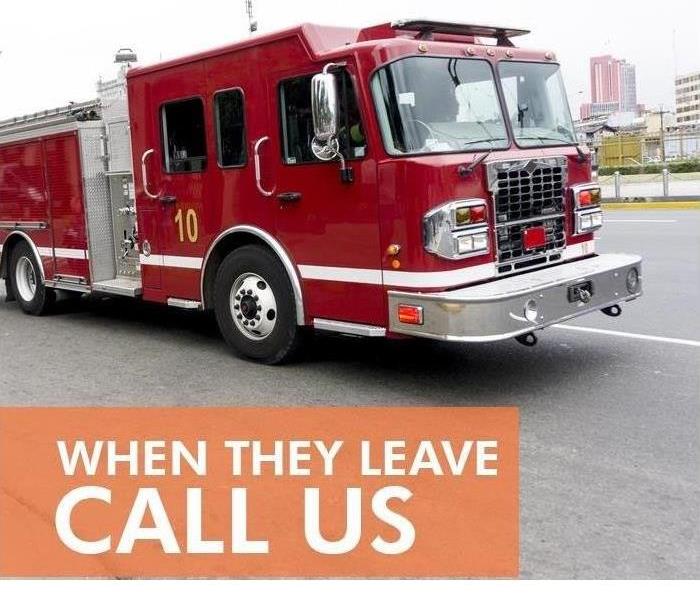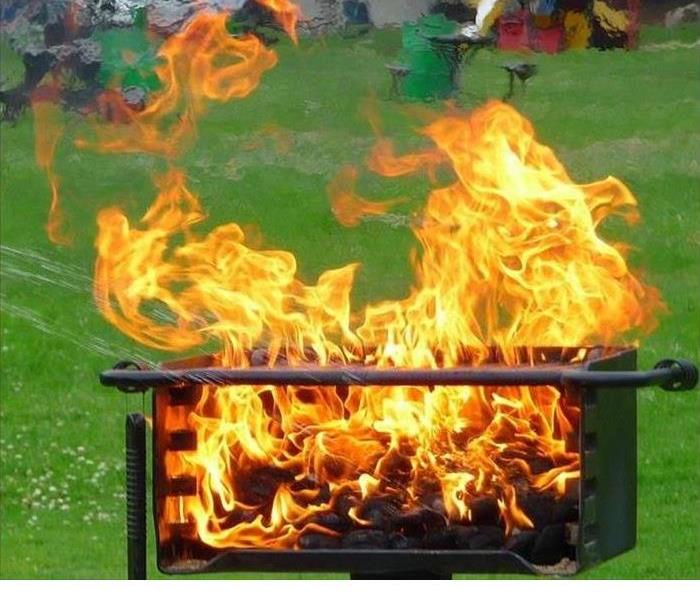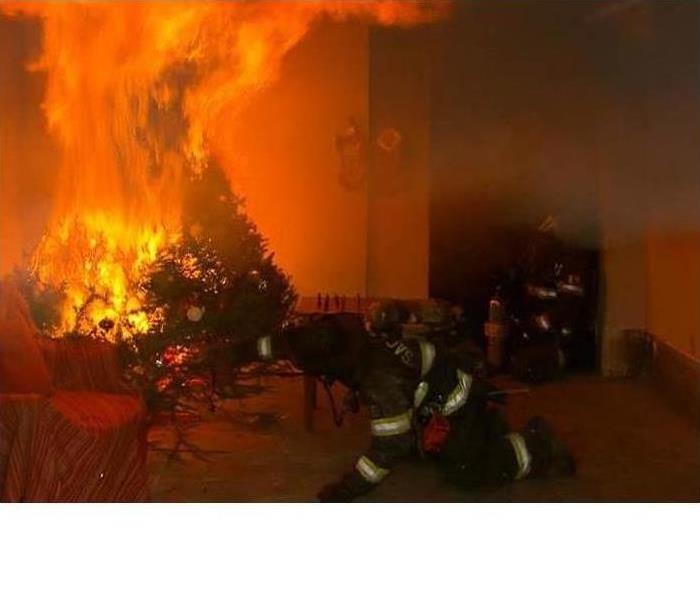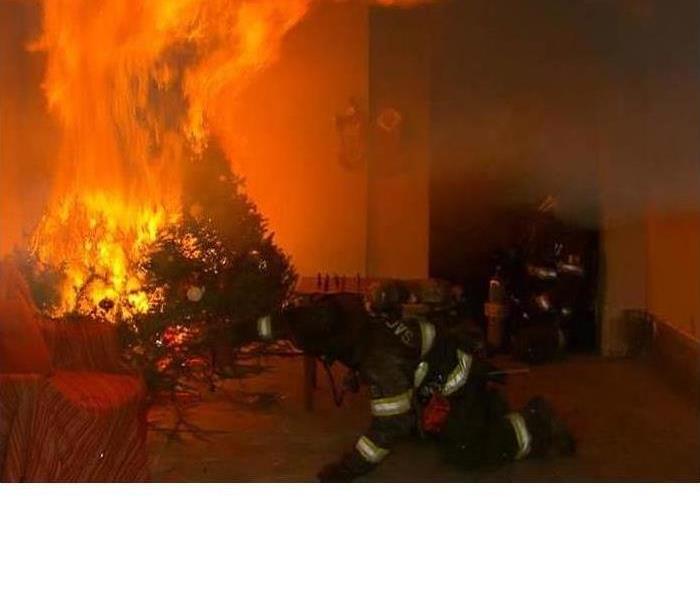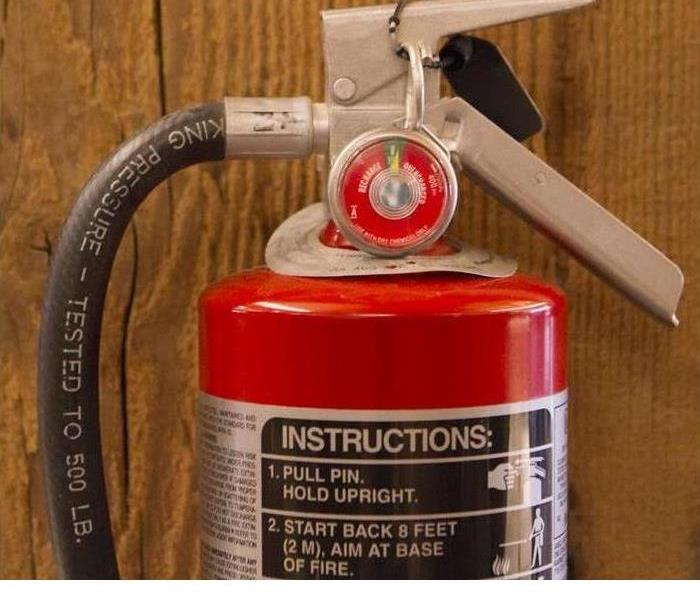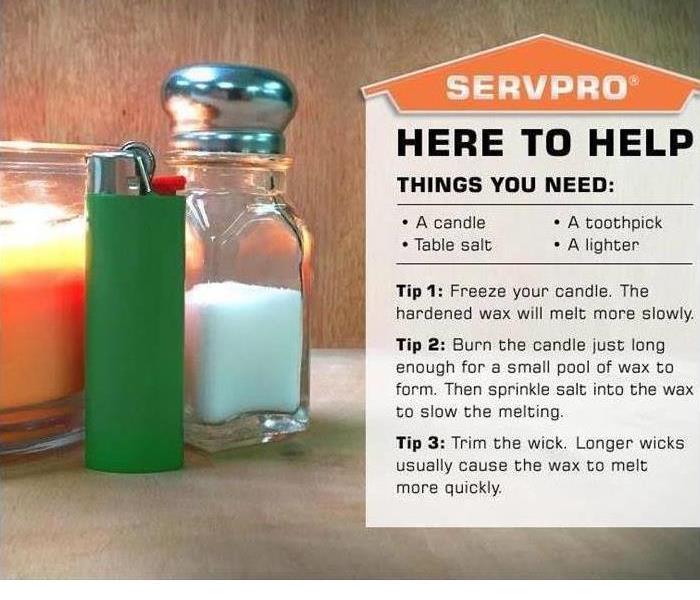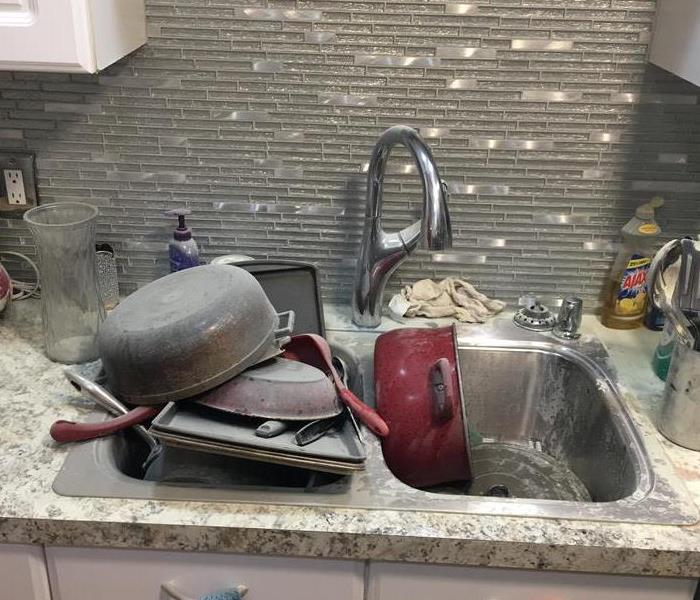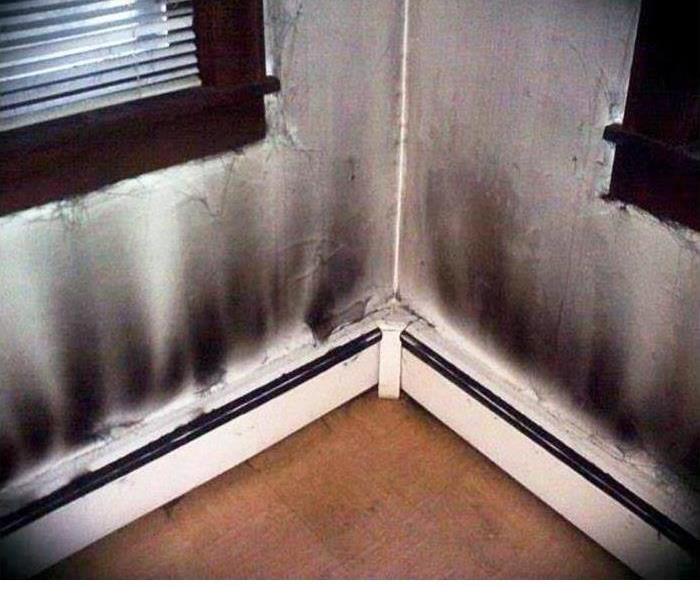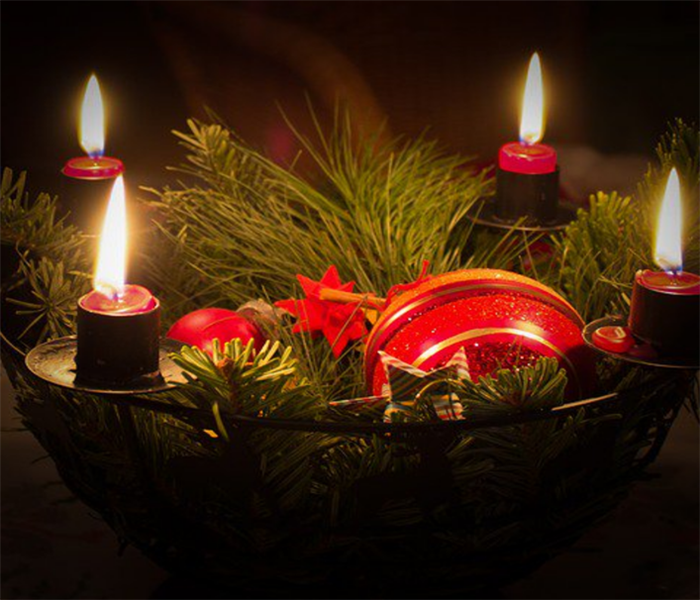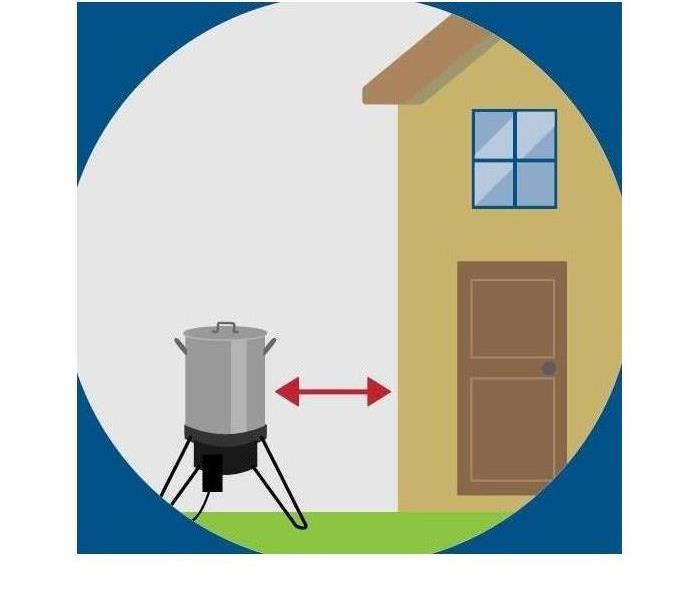Archived Fire Damage Blog Posts
How SERVPRO Neutralizes Smoke Odors After a Fire
2/3/2025 (Permalink)
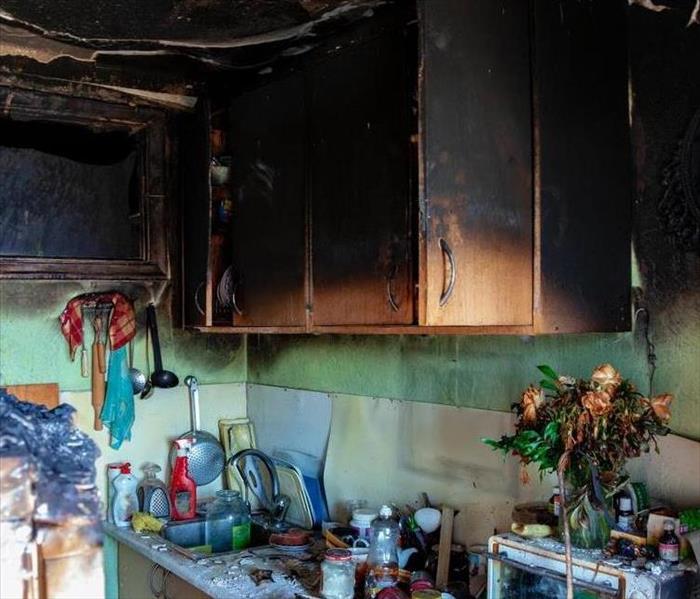 This kitchen is damaged from a recent fire and contains smoke damage
This kitchen is damaged from a recent fire and contains smoke damage
Experiencing a fire in your home or business can be devastating, leaving behind physical damage and lingering smoke odors that can be difficult to eliminate. SERVPRO® of Eastern Niagara County understands the complexities of restoring a property after such an incident. Our team employs advanced techniques and state-of-the-art equipment to neutralize smoke odors effectively. By utilizing specialized methods, including air scrubbers, thermal fogging, and ozone treatments, we ensure that your space is restored to its pre-fire condition. Every fire damage situation is a little different and requires a unique solution, so choose SERVPRO, a trusted partner in your fire recovery process.
Contact SERVPRO, Your Smoke Damage Restoration Specialists
If you have recently experienced a fire at your home or business, removing the odor of smoke can often feel overwhelming. At SERVPRO of Eastern Niagara County, our restoration technicians offer fast, 24-hour services to ensure the smoke restoration process begins immediately after a fire. Our highly trained and IICRC-certified technicians utilize cutting-edge technology and proven techniques to remove soot and smoke residue, ensuring your property is restored to pristine condition. SERVPRO offers a wide range of comprehensive fire and smoke damage restoration services to manage every phase of the restoration process.
Smoke & Odor Remediation
Smoke and combustion odors can often be a substantial obstacle for restoration professionals when finalizing fire recovery. SERVPRO uses a combination of ULV Foggers, Negative Air Scrubbers, and Hydroxyl/Ozone Generators to neutralize and eliminate smoke and odors lingering after a fire.
Carpet & Upholstery Cleaning
After a fire, soot and smoke can cover your belongings, and they can be stubborn to remove without professional help. Removing smoke residues and soils like soot from surfaces ultimately requires leading cleaning agents specific to our brand and techniques. Through surface testing, we can identify the efficient and thorough cleaning approach to remove oily or acidic soils and protect the underlying material from staining and destruction. From cleaning floors, ceilings, and walls, SERVPRO can minimize the damage and restore your property to its preloss condition.
Air Duct Cleaning & HVAC Restoration
After a fire, the importance of thorough cleaning and restoration cannot be overstated, especially regarding your home's air ducts and HVAC system. SERVPRO of Eastern Niagara County offers comprehensive Air Duct Cleaning & HVAC Cleaning services that are essential for removing smoke, soot, and other contaminants that can linger in your ventilation system. These harmful particles can compromise indoor air quality and pose health risks to the occupants if left unaddressed. Our expert technicians use state-of-the-art equipment to meticulously clean and restore your HVAC system, ensuring it operates efficiently and safely. By choosing SERVPRO of Eastern Niagara County, you can breathe easier knowing that your home's air quality is restored to a healthy state, allowing you to move forward with peace of mind after a fire.
Learn How SERVPRO Can Help You After a Fire
SERVPRO of Eastern Niagara County is dedicated to providing exceptional fire damage restoration services to help you recover after a devastating event. Our expertise, advanced technology, and compassionate approach ensure that your property is restored to its pre-fire condition as quickly and efficiently as possible. Whether it's removing smoke odors, repairing structural damage, or providing guidance through the insurance process, our team is here to support you every step of the way. Trust SERVPRO to be your partner in recovery, allowing you to focus on rebuilding your life after a fire. Contact us today!
How Smoke Damage Affects Your Home and Health Long After a Fire
10/28/2024 (Permalink)
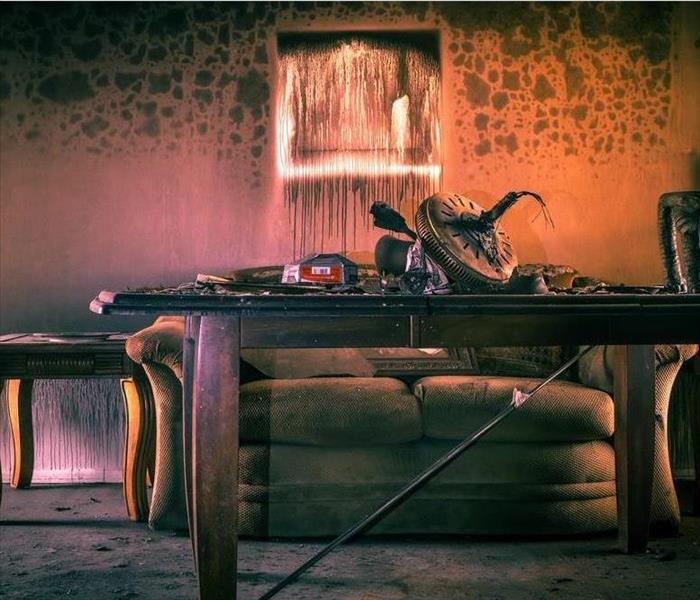 Living room affected by fire and smoke damage
Living room affected by fire and smoke damage
Experiencing a fire in your home can be devastating, and unfortunately, the damage doesn't end once the flames are extinguished. Smoke damage can linger, causing long-term effects on your property and health. At SERVPRO® of Eastern Niagara County, we understand the complexities of smoke damage and are here to help you navigate the fire damage restoration process and remove unwanted odors.
Does Smoke Affect Your Home?
Smoke damage refers to physical damage resulting from smoke rather than damage from the actual fire. When a fire occurs at your home in Niagara County, smoke and soot particles can infiltrate every corner of your property. Smoke and soot particles are acidic and can corrode metals and discolor walls, ceilings, and fabrics well after extinguishing the fire. The smell of smoke can also be incredibly pervasive, seeping into carpets, drapes, and furniture, making it challenging to remove without professional odor removal.
Common Items Damaged by Smoke & Soot Odors
Smoke can damage structural elements of your home, including insulation, ductwork, and framing, potentially compromising the safety and stability of the building. The longer the smoke residue sits, the more difficult it becomes to clean and the more extensive the damage. That's why it's crucial to address smoke damage as soon as possible and contact SERVPRO of Eastern Niagara County for professional smoke restoration and odor removal services. The most common items smoke and soot can damage in your home include the following:
Carpets & Upholstery
Carpets are particularly susceptible to smoke damage, as they can easily absorb odors and soot. Luckily, the SERVPRO System offers several cleaning options to restore any upholstery or carpet damaged by smoke.
Ceilings, Floors, & Walls
Smoke can leave a visible residue on floors, walls, and ceilings, which can be challenging to remove with standard cleaning methods. The soot can also penetrate surfaces, causing discoloration and damage over time. Trust SERVPRO to restore your home from smoke damage with our proprietary cleaning products and methods.
HVAC Systems
Your heating, ventilation, and air conditioning (HVAC) system can circulate smoke particles throughout your home, spreading the damage. The system's filters, ducts, and components can become clogged or contaminated, affecting air quality and system performance. Ensure your indoor air quality is safe after smoke damage with SERVPRO's professional HVAC Cleaning.
Hire SERVPRO to Clean Your Smoke-damaged Items
Restoring your home after smoke damage requires professional expertise and specialized equipment. SERVPRO of Eastern Niagara County's smoke damage restoration technicians are equipped to handle all aspects of smoke damage restoration, from cleaning and deodorizing to repairing and rebuilding. Our team uses advanced techniques and state-of-the-art equipment to clean and restore your property and belongings thoroughly. Call SERVPRO at (716)815-3700 to get 24/7 restoration help today!
Fire Pit & Outdoor Fire Safety | SERVPRO of Eastern Niagara County
6/16/2023 (Permalink)
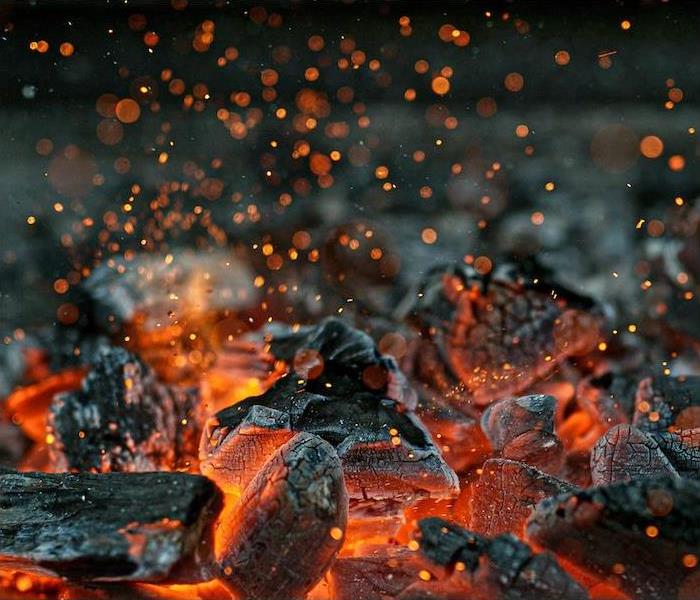 Fire pits can be dangerous. If your fire spreads outside its pit, call SERVPRO of Eastern Niagara County to restore your home to preloss condition.
Fire pits can be dangerous. If your fire spreads outside its pit, call SERVPRO of Eastern Niagara County to restore your home to preloss condition.
Is there anything better than gathering outside with the family? Watching the kids play peacefully and hearing the crickets chirp and birds sing can be magic in and of itself, but add a fire pit or throw some burgers on the grill and you have a night where core memories are made.
Enjoying our outdoor space often includes an open flame, even if it’s just a few candles to set the mood (and deter the bugs). We may also need to use fire to keep our yards clear of debris, especially when the leaves start falling.
Any time you have an open flame outside, though, there is the potential for things to go very wrong very quickly. Fortunately, with a few precautions in place and a little extra planning, you can keep your home and your family safe from fire disasters.
Fire Pit SafetyFire pits are a great way to create a common space to gather with your family in the exterior space of your home. Sitting around a fire evokes all the warm and fluffy good feelings you enjoy sharing with the people you love most, and marshmallows are always a welcome treat.
When they are not handled correctly, however, fire pits can turn dangerous quickly.
Fire pits should be placed at least 10 feet from any existing structures, and loose limbs, leaves and other debris should be cleared out before every use. Only use materials intended for burning in a fire pit, and never add accelerants to the flames. Avoid wearing loose clothing while you are near the fire pit, and make sure kiddos and pets can stay a safe distance away.
Always check local codes before adding a fire pit to your yard. Never leave a fire pit unattended, even if it means staying up well past your bedtime to ensure every red ember is extinguished.
Open Flame SafetyIf a fire pit isn’t for you, there is a good chance you will still use some kind of open flame when you spend time outside. Candles and grills are common sources of both house and wildfires when they are not used appropriately.
Burn candles on a non-flammable surface, and if you are lighting any kind of torch-style candle, place it away from anything flammable and only use approved fuel sources. Never leave a hot grill unattended, and make sure you are cooking in an open space to prevent flames from reaching any overhangs as well as to avoid any fume inhalation.
If you plan to burn debris, always check for permit needs, burn bans and the weather. Skip open flames altogether when the wind is high or there hasn’t been rain in a while.
Enjoy every moment by staying fire-aware and preventing unnecessary fires in your outdoor living space.
Do you have fire or smoke damage in your home? Contact us for fast restoration.
Fire Damage Restoration Services
7/28/2022 (Permalink)
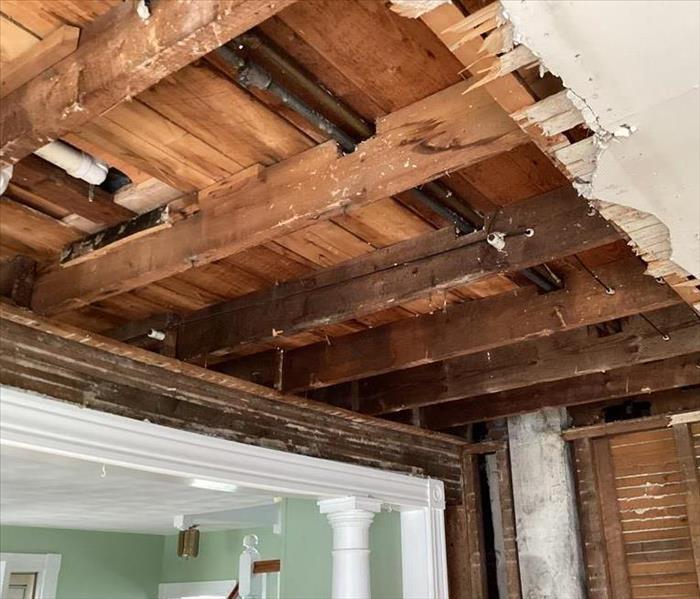 SERVPRO fire damage restoration services are available for commercial & residential properties in your area. Call us now.
SERVPRO fire damage restoration services are available for commercial & residential properties in your area. Call us now.
Fire damage repair services are available 24/7 for the simple fact that when response and clean-up of a fire is immediate, the easier and more likely it is to restore and repair the structure and the items inside. This is why SERVPRO's project managers arrive as soon as possible to review your property and offer you the most efficient path forward.
During these first hours after a fire has occurred and it is safe to reenter the property, we are prepared to begin removing items that can be cleaned and restored. Our ability to save items thought lost in a fire damage amazes many of our customers. Sometimes it is sentimental items, like clothing and photos, other times it is crucial items like electronics and documents that contain personal and important information. Our team is adept and restoring all of these items and also larger items like furniture and appliances.
Our team is also prepared to manage large properties damaged by fire such as retail properties, industrial properties, and entertain & government buildings. We have the ability to quickly scale up our operations and mange large projects like these.
If your home or commercial property is damage by fire, soot, smoke or water call us immediately. Our team is available to help clean up your property immediately and can provide on-demand construction services if needed.
Fire Damage Restoration Services Near Niagara County
7/5/2022 (Permalink)
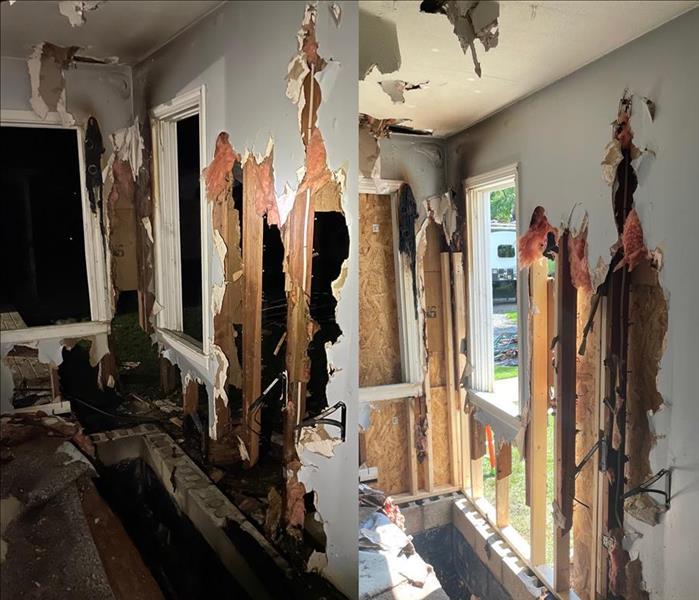 SERVPRO of Eastern Niagara County is available when fire damages your commercial property, call us 24/7.
SERVPRO of Eastern Niagara County is available when fire damages your commercial property, call us 24/7.
When a fire damages a business property there are many factors that need to be considered in order to achieve a quick and successful recovery. First, it is essential to factor in the type of business location that has been affected. Retail locations such as supermarkets, restaurants, food storage, food supply, or food preparation facilities need to be treated differently than clothing retail stores or other facilities that produce non-perishable items. This is why contacting SERVPRO is the best call you can make when your commercial business property is damaged by fire.
We are the experts in fire restoration and clean-up services and provide 24/7 response to ensure we are able to be there when your property and business require our immediate attention. Your project manager will come prepared to scope your property and provide an immediate estimate for services. We will contact your insurance providers and provide them with all information needed to begin restoration immediately.
Once approved we will begin to block off damaged areas of your commercial property to avoid contamination/damage in areas where the property was not affected. If possible we will try to allow you to keep operations running partially. We will remove items that can be saved such as retail items, documents, electronics, and the like. We are able to restore most items that have not been directly affected by the fire.
Next, we will begin to clean up and restore the property. We will scale up production to match the size of the damage and to provide the correct amount of equipment to ensure all affected areas are being serviced simultaneously. Finally, we will provide construction services as needed to repair your property and get your business back up and running at 100%.
SERVPRO Fire Damage Clean Up Near You
6/27/2022 (Permalink)
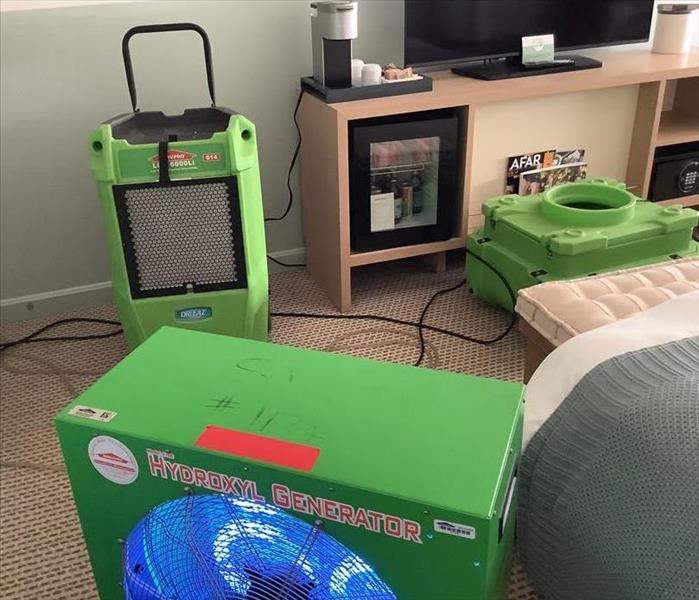 SERVPRO fire damage restoration services is available to help you 24 hours a day when fire damages your commercial or residential property.
SERVPRO fire damage restoration services is available to help you 24 hours a day when fire damages your commercial or residential property.
SERVPRO is available to help you if your normal janitorial crew is unable to handle fire damage at commercial properties. We offer quick restoration and clean up services, so your commercial property can run as normal and get back at 100% as quickly and efficiently as possible. We understand that a commercial property fire can cause significant damage. Without the proper equipment and experience in cleaning up fire damage, it can be very difficult to restore your commercial property.
Our company is the most qualified in fire damage repair and cleanup. We also have many sister franchises that enable us to rapidly scale up production for commercial projects. This makes us the best option for commercial properties that are affected by fire, such as hotels, shopping centers and retail stores, museums, hospitals, government buildings, manufacturing units, and multi-family houses. We provide exceptional service and quick response to any property we visit. Our project managers are highly trained to thoroughly review your property, and then quickly give you an estimate to repair the damage. If you are approved, our project managers will meet with property owners and managers to discuss your restoration. We'll also provide daily updates and communications.
There are several things to remember when you have a fire damaged your property. First, the source must be identified and the structure must then be declared safe before restoration can be started. This area of damage is most likely to be the most critical when looking at the cause of the fire. It might not be the hardest area to clean. This is because the cleaning team will need to cover more territory and provide more manual labor since soot cleanup can be labor intensive. This scenario is not uncommon as we have the resources and expertise to increase our labor and production so that more technicians and equipment are available.
Please contact us immediately if any commercial property has been affected by fire. If you have any questions, our project managers will be available 24 hours a days.
Fire Damage Cleaning Services 24/7 Niagara County NY
5/16/2022 (Permalink)
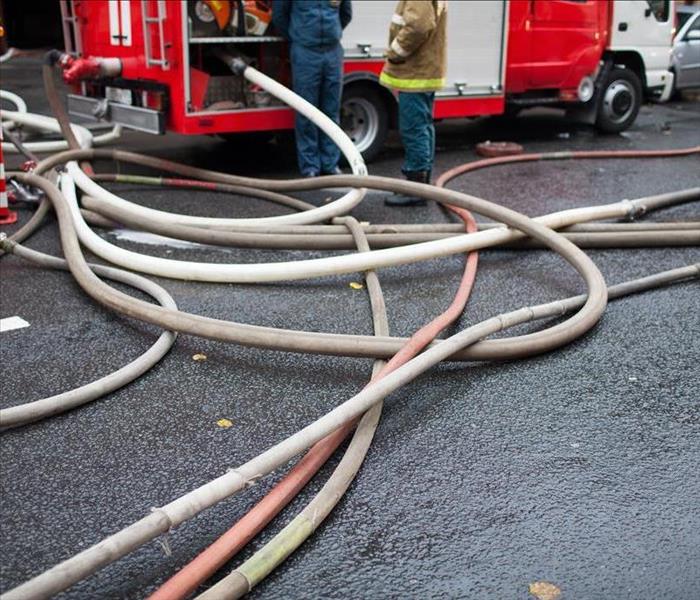 SERVPRO of Eastern Niagara County is available when fire damages your residential or commercial property. We can provide immediate services as needed.
SERVPRO of Eastern Niagara County is available when fire damages your residential or commercial property. We can provide immediate services as needed.
Fires can cause havoc in residential and commercial properties. Even a small fire might cause damage that could require extensive cleanup. SERVPRO is here to help you with all aspects of restoration.
We are ready to bring our labor force whenever we need it. The quicker we can clean up after an incident, the easier it will be to reverse the effects of smoke odors, soot and general damage. We will clean every surface and use the latest air-moving and air purification equipment.
After we have removed evidence of fire, we can assess damage to offer repair or construction services. Our team is always prepared to go. Construction will start as soon as you and your insurer approve the estimates.
We provide upfront and transparent pricing for all services. Daily communications are provided to you and your provider to keep both you and the insurance company informed about progress, and any unforeseen events that may occur during construction. We offer a wide range of services in these cases, including plumbing and electric, as well insulation, painting, and finish carpentry.
If your property has suffered a fire, we are here to help!
24/7 Fire Damage Repair Services
5/2/2022 (Permalink)
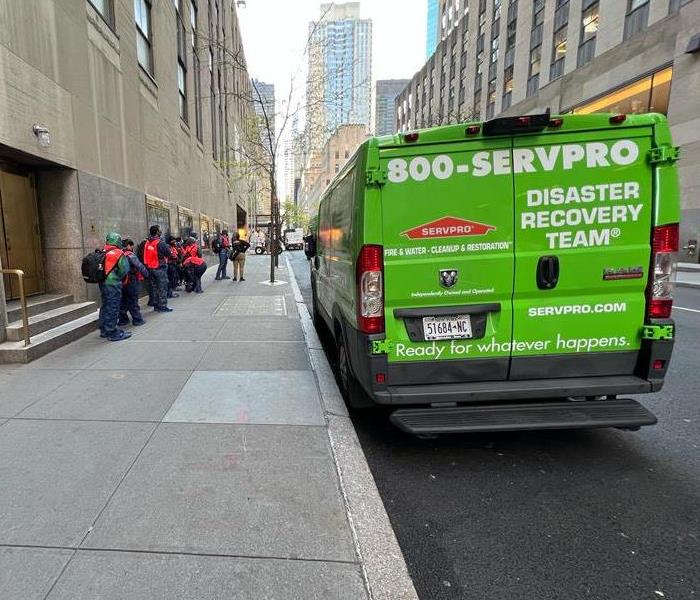 SERVPRO of Eastern Niagara County is available when your property requires emergency fire damage clean up and repair.
SERVPRO of Eastern Niagara County is available when your property requires emergency fire damage clean up and repair.
The situation can quickly get overwhelming when your property has a fire. It can be hard to assess the damage and you'll need to make quick decisions depending on the extent of the damage. Our team is here to guide you. A project manager will assess the property immediately upon arrival. If the fire has caused major damage, the manager will offer to protect it from outside elements.
Then, we can work closely with your insurance company and you to begin restoration immediately. We respond quickly to minimize damage and shorten the restoration time. Then, we can provide all information required by your insurance company so that you are fully covered throughout the process. We can also provide transparent and upfront pricing for any necessary reconstruction or repairs. This allows you to quickly submit reconstruction estimates to insurance providers and save on costly services that may not be covered. SERVPRO's Guarantee of Quality workmanship backs our construction work so that you can be sure the job is done correctly.
What are the Right Steps for Fire Damage Restoration of a Lockport Home?
8/23/2021 (Permalink)
 SERVPRO technicians are trained and IICRC certified for all matters of restoration. Call now for the fire damage remediation services that are needed.
SERVPRO technicians are trained and IICRC certified for all matters of restoration. Call now for the fire damage remediation services that are needed.
Calling SERVPRO and its Team of Experts is the First Step to Restoring a Lockport Home After a Fire
When a fire happens in a Lockport home, it is hard to discern where to start addressing its consequences. The flames and smoke cause damage that can spread much further than one would expect, making it difficult for the average homeowner to organize the sequence of cleanup steps. Calling a professional fire restoration team can help mitigate losses and preserve some of your belongings.
SERVPRO is available for fire damage restoration for the Lockport community. Our fully trained staff arrives and safely considers the damage caused by the fire itself and by firefighters attempting to fight it. Fire damaged homes usually require water extraction and fire and smoke remediation services, both of which our team is ready to offer.
As our SERVPRO staff inspects your home, there may be areas unaffected by the incident, and we attempt to preserve those intact as much as possible. Some steps we might take to prevent the spread of fire damage throughout your home can include-
- We can establish physical barriers between areas with plastic sheeting and set up clean zones where we can store undamaged goods.
- Provide move-out services where we physically inventory and remove clean items from your home and keep them in an offsite location to avoid contamination. Once the cleanup is done, we return each item to its original spot.
- Addressing your home ventilation system and cleaning it as needed. Controlling the paths through which soot and smell particles can travel helps us protect part of your home outside of the fire’s reach.
SERVPRO of Eastern Niagara County is an expert in fire damage restoration, and we’re ready to help as soon as you contact us at (716) 694-7776. Place your trust in us, and let us work hard to bring your home back to pre-fire condition.
Local Fire Restoration Services for Lockport Residents
7/28/2021 (Permalink)
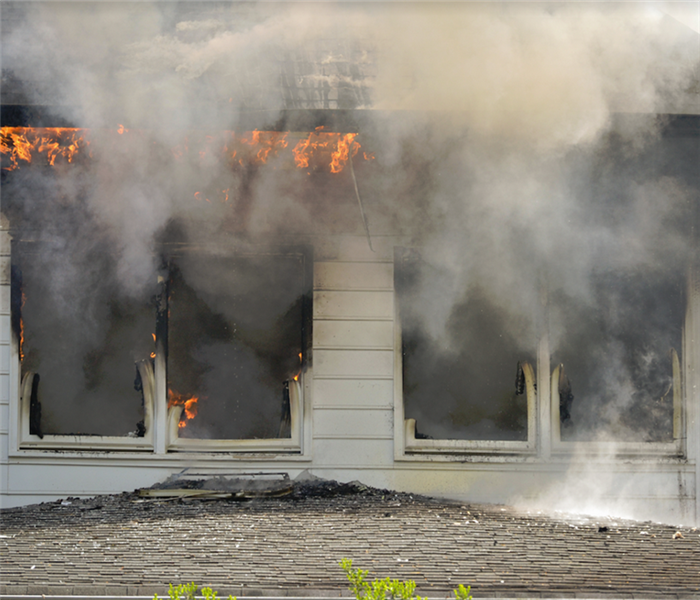 Team SERVPRO has the equipment and tools to tackle the fire damage situation in your home. We are standing by 24/7 to handle your emergency.
Team SERVPRO has the equipment and tools to tackle the fire damage situation in your home. We are standing by 24/7 to handle your emergency.
SERVPRO is Available 24/7 for Emergency Fire Restoration – Call Us to Your Lockport Home After a Fire
A small fire in your finished basement, a medium blaze in your kitchen, or a substantial house fire that impacts several spaces – each one calls for skilled fire damage restoration. SERVPRO knows how to handle whatever fire and smoke damage that you may experience in your Lockport home. We also arrive fast so that you can get the remediation process going as quickly as possible. Before you know it, your home gets returned to pre-fire condition, “Like it never even happened.”
There are several challenges that fire and smoke restoration technicians (FSRT) experience when called for fire restoration in Lockport. Even the most minor fire event can bring a host of issues, such as:
- Stubborn smoke residue left on a variety of surfaces
- Charred building materials that call for complete removal and replacement
- Water damage and moisture left from first responders extinguishing the flames
- Hidden smoke damage that could lead to foul odors if not addressed fully
- Unsafe structural elements
Smoke damage is a significant issue that our IICRC-certified technicians face when handling house fire clean up. The kind of residue present and the surfaces it touches will dictate which cleaning method is required. With loose dry particles, our technicians may use dry cleaning with brushes, sponges, or hand vacuums. Wet, heavier residue often calls for dissolving with the help of solvent-based cleaning agents. These products loosen the grip on surfaces so that the technician can start carefully wiping it away.
Once you get in touch with SERVPRO of Eastern Niagara County for fire restoration, we will have a team at your door within hours to begin the assessment. Call us to have our Green Fleet dispatched by dialing (716) 694-7776.
Does SERVPRO Provide Fire Restoration Services to Lockport Residential Customers?
7/5/2021 (Permalink)
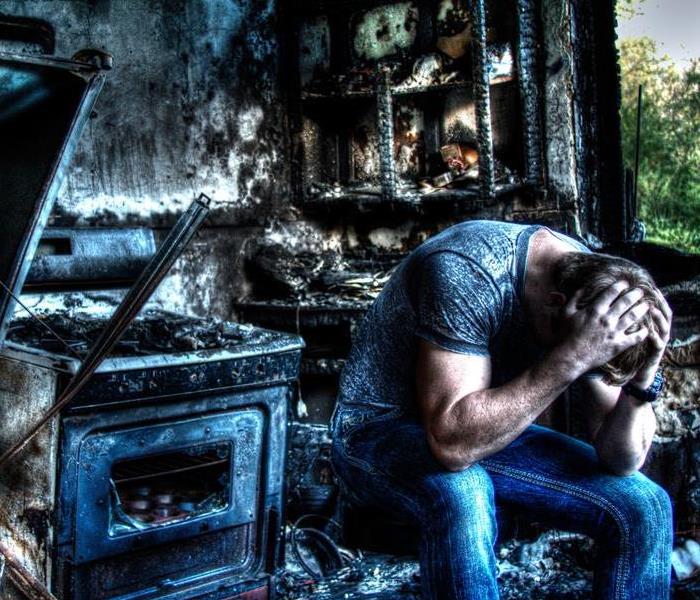 Please do not hesitate to call SERVPRO of Eastern Niagara County. We are always here to help.
Please do not hesitate to call SERVPRO of Eastern Niagara County. We are always here to help.
How Long Does House Fire Clean Up Take in Lockport After a Fire?
After a fire in Lockport, even a small fire, there is usually damage caused during the fire, and there is damage from the smoke residues, the smoke odors, and the materials used by the fire department to quell the blaze. It may feel like there are burnt items everywhere, and the entire room or even house is covered with a smoky residue.
SERVPRO provides fire restoration to Lockport residential homeowners. We use various approaches to cleaning your home after a fire, including mechanical scrubbers, lubrication of difficult to remove soiling, chemical action, and suspension or dispersion to loosen soiling and extract the soil along with the cleaning product. The action taken may vary with each item that needs to be cleaned depending on porosity.
One of the factors that are also important during cleaning activities is dwelling time. Dwell time is the amount of time needed for the chemical action to work and dissolve the soils. During house fire clean-up activities, we ensure that sufficient time is allowed to thoroughly remove all of the smoke residues that may have been distributed throughout your home.
Our services also include:
- Water & Fire Damage Restorations
- Smoke Damage Restoration
- House Fire Clean Up
Call SERVPRO of Eastern Niagara County for fire restoration in Lockport and surrounding areas. We can help 24/7. Call (716) 694-7776.
Does SERVPRO Provide Deep Cleaning and Fire Damage Restoration in Lockport?
6/25/2021 (Permalink)
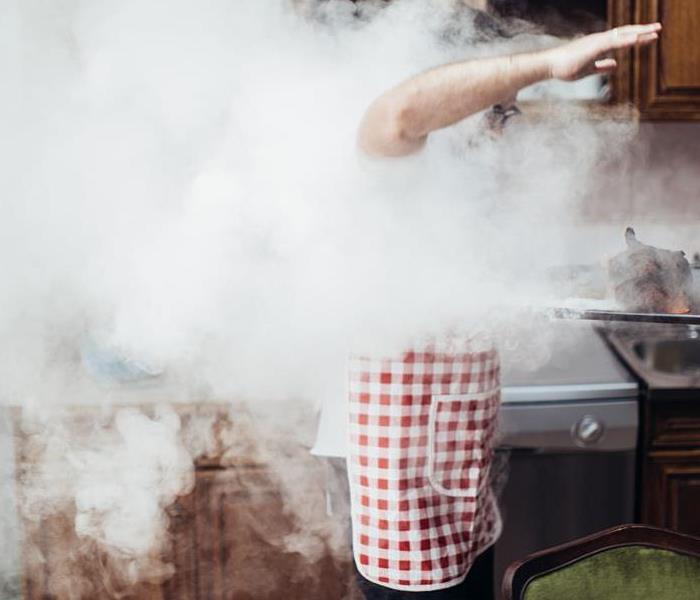 No matter the size of the fire, SERVPRO of Eastern Niagara County can help get your home back to normal.
No matter the size of the fire, SERVPRO of Eastern Niagara County can help get your home back to normal.
SERVPRO Provides Deep Cleaning House Fire Cleanup Services in Lockport
A house fire in Lockport can be devastating for a homeowner. Even a small fire in the kitchen around the stove or the oven can cause substantial damage delivering smoke residues throughout the house. The immediate area of the fire may scorch kitchen cupboards and appliances and leave residues on all surfaces. Smoke odors from the fire may be carried throughout the home on natural air currents or even distributed by the heating system.
SERVPRO responds in less than four hours from your call to provide fire damage restoration services in Lockport homes. We immediately assess the situation to determine the optimum approach to cleaning up after a fire and removing all traces of the fire, including smoke residue damage.
Smoke remediation involves the removal of all damaged items that cannot be cleaned or repaired. We record everything that falls into this category for later claims to your home insurance company. The next step involves removing smoke residues and soot from all surfaces, including porous and nonporous items. We clean, sanitize, disinfect all items and then focus on eliminating lingering odors from the fire.
SERVPRO provides the following services to improve air quality and meet the needs of your fire-damaged home:
- Fire and Smoke Damage Restoration and Cleanup
- Water & Fire Damage Restorations
- House Fire Clean Up
Call SERVPRO of Eastern Niagara County for fire damage restoration in Lockport and surrounding areas. We can help 24/7. Call (716) 694-7776.
Fire Damaged Homes in Lockport Need Professional Restoration
5/13/2021 (Permalink)
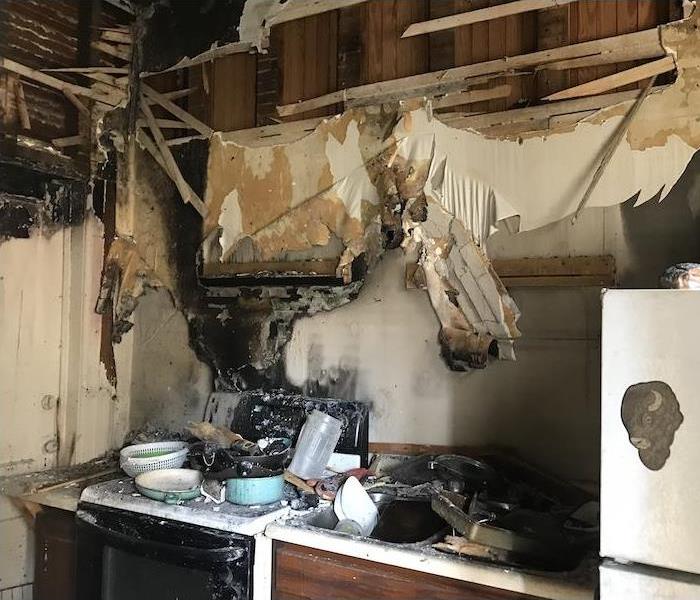 Professional fire damage clean-up is very important to the homeowners. SERVPRO takes pride in the work we do for all of our customers.
Professional fire damage clean-up is very important to the homeowners. SERVPRO takes pride in the work we do for all of our customers.
SERVPRO Provides Fire Cleanup Do Lockport Residents
When a fire occurs, using professional cleaning and restoration services such as SERVPRO often reduces the fire damage claim costs. Many companies replace everything, which is one of the leading insurance costs. Fire damage restoration services usually are a fraction of the cost of replacement or resurfacing.
Lessen Expenses with the Principles of Cleaning
When we arrive and begin fire cleanup in your Lockport home, our goal is always to restore whenever possible. There may be things we have to dispose of, but if we can restore them, we will. We restoring materials to preloss condition we follow the basic principles of cleaning:
- Locate smoke residue – we do this by carefully inspecting the affected area.
- Identify the type of residues – this is done, so the proper cleaning agent is used.
- Identify the surface type – which cleaning methods and agents get used are based on the type of smoke residue and the type of surface.
- Capture and remove residues – we use wet and dry cleaning processes to release and remove residue particles away from the surface.
- Dispose of residues – we properly dispose of all cleaning waste and debris.
Fire and smoke damage significantly impacts homes and can bring life to a halt. SERVPRO provides house fire clean-up that allows you to get back to normal as quickly as possible. For smoke remediation, contact SERVPRO of Eastern Niagara County at (716) 694-7776.
Small-Group Wine Tasting in Lockport
1/22/2021 (Permalink)
 It will be exciting to see the community enjoying the Spring Lake Winery!
It will be exciting to see the community enjoying the Spring Lake Winery!
Experience the Spring Lake Winery Near Lockport Responsibly
On 24 January (and later in the month), Lockport residents can gather in small groups to experience the Spring Lake Winery in a unique, and socially responsible, way. The owners have renovated a rustic cabin to create an environment perfect for wine tasting and to get away from the events of this last year.
A per person fee of $25 includes comfortable seating for relaxed entertaining with complimentary transportation by golf cart and non-alcoholic beverages. The bar/kitchenette is stocked with Spring Lake’s newest releases chosen by the group in advance. Dining choices are available and full-wine service is also available at additional costs.
Walk Around Lockport Vineyards
Guests are encouraged to explore the nearby Spring Lake vineyards. As the sun begins to set, they can return to the cabin for more wine and snacks while gathering around a fire pit out front.
For information about fire damage cleanup operations in Lockport or to schedule a service visit, contact SERVPRO of Eastern Niagara County. One call to (716) 694-7776 can quickly help return your home to a clean, safe condition.
Can Lockport Properties be Returned to Normal after a Fire Through Cleaning?
10/18/2020 (Permalink)
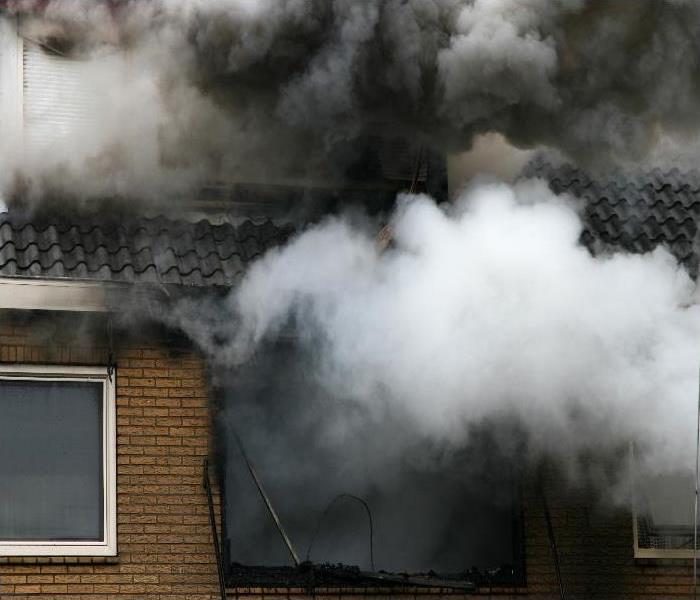 Restoring an HVAC system can be time-consuming, but it is also essential to return your home to a preloss condition.
Restoring an HVAC system can be time-consuming, but it is also essential to return your home to a preloss condition.
Cleaning Smoke and Soot Residues is a Crucial Part of Fire Damage Restoration. SERVPRO Can Help Get your Lockport Residence Back to Normal.
How does smoke spread through a property?
Smoke damages are among the chief causes of concern for your Lockport home. While firefighting efforts can often contain the fire source, smokes are much more difficult to trap in one area. These chemical-filled gases rise upwards with heat and pressure while always seeking cooler air. The result is a structure that shows signs of smoke residues both in the area of damages and on walls and ceilings throughout. Since the residues come from the gas, they can reach and enter almost any spaces in the home. It is common to find smoke residues in cabinets, drawers, electrical fittings, textiles, and mechanical systems in the house. In some cases, an odorous smoke can permeate the building assembly itself, affecting insulation and assembly frames. Our technicians can help you to locate and remove the residues through established cleaning methodology and training.
Do Heating, Ventilation, and Air-conditioning (HVAC) systems need replacing after a fire?
Inspecting HVAC systems is an essential part of fire damage restoration in your Lockport home. The ductwork can transport hot smoke throughout the house and should be switched off, along with any electrics, immediately when a fire breaks out. Unfortunately, switching off the mains electrics is not always possible. That can lead to large amounts of smoke entering an HVAC system, overloading any inbuilt filters, and redistributing throughout the home. Cleaning a system like these is usually only necessary in situations where there is moderate to significant damages. Replacing an HVAC system is unnecessary unless there is material damage to the mechanics. If mechanical ducts are not cleaned during fire restoration, they can store smokes and redistribute them into the clean parts of the structure once power is restored.
What factors influence HVAC damage from the fire?
• The location of the fire is compared to the HVAC system and whether smoke has entered the return or supply side of the ductwork.
• The length of time that a housefire was burning before the flames where extinguished
• Whether the blower for the HVAC was in operation during the fire, although air-pressure can force smoke into a switched off the system as well.
What qualifications do you need to inspect an HVAC system?
Conducting repair of an air-conditioning system is a job for a specialist. However, fire restoration technicians can work with the non-moving parts of the system to clean and restore them. Some knowledge is required to understand what parts of a system could be damaged. Mechanical components like turning vanes, dampers, cooling coil, and mixing boxes should undergo tests to ensure there is no malfunction. Some of the parts can be replaced relatively cheaply. The ability to disassemble some or all of the HVAC system is also useful during the inspection to gain access to the interior ductwork and make an informed decision regarding the restoration requirements. If necessary, SERVPRO can arrange for a subcontractor to replace some or all of the HVAC systems, which can be included within your claim report allowing you to only deal with one point of contact during the service.
What approaches influence HVAC restoration?
• The material construction of the system, whether sheet metal, duct board or flex duct. Whether there is insulation in the ductwork.
• Are smoke residues severe enough to justify the system's disassembly and whether the mechanical components may need removing. HVAC disassembly is reserved for specifically qualified technicians
• The condition of the filters on both the return and supply side of the system. These may need cleaning or replacing
How do technicians clean ductwork?
Cleaning the ductwork of an HVAC system is an effective mitigation procedure against further damages and is often necessary for fire restoration. First, we remove air intakes and vent registers as well as air-handling filters. Negative air pressure or vacuuming can help to remove soots or dust from inlets and outlets in the system. Accessible areas can also be washed. Duct sealer can be applied to the HVAC using fogging equipment and the HVAC systems blower to distribute and is an efficient way of controlling malodors that may occur due to the fire.
What parts of HVAC fire damage affect a home?
• The type of smoke residues that are present within the ductwork
• The extent of residue, whether major, moderate or minor
• The presence of malodor
Restoring an HVAC system can be time-consuming, but it is also essential to return your home to a preloss condition. Contact SERVPRO of Eastern Niagara County at (716) 694-7776.
Can Soot Be Removed from Surfaces after Fire Damage?
9/29/2020 (Permalink)
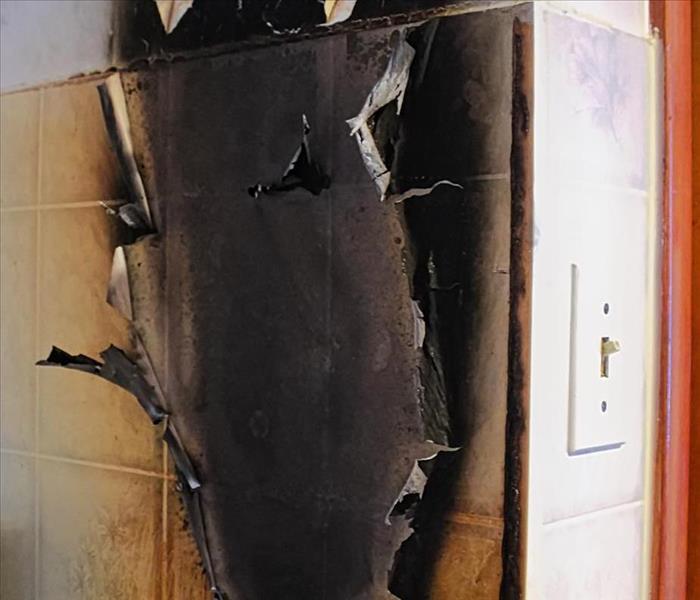 Lockport Home Damaged by Smoke and Fire--Like this Wall? Call SERVPRO for Cleanup, and Restoration
Lockport Home Damaged by Smoke and Fire--Like this Wall? Call SERVPRO for Cleanup, and Restoration
SERVPRO Provides Fast Fire Mitigation to Remove Smoke Residue from Lockport Homes
Soot is a smoke residue that has settled and is a troublesome material that SERVPRO technicians deal with daily. There are different types of soot, and each one can require different cleaning techniques. If you are dealing with fire damage in Lockport, you want professionals who understand what needs to be done for proper mitigation.
How is Soot Removed from Surfaces?
When determining the methods for removing soot, the combusted materials, and the makeup of the surface need to be taken into consideration. Kitchen fires are the main reason for residential fires and often involve grease fires. This leaves protein residues on the surfaces. Wood burning and oil furnace puff backs produce a different type of smoke residue. Our technicians pre-test surfaces and use the best approach depending on the material getting treated. Our professional equipment and advanced technology allow us to provide quality fire restoration in Lockport and return your home to preloss condition. The processes used can include:
- Dry Ice Blasting– Uses C02 pellets that sublimate (from solid bullet to gas) after contact. This method can be a robust or gentle abrasive cleaning process that can be used on things such as exposed beams.
- Soda Blasting– Baking soda combines with pressurized air to remove lightly charred residue on surfaces. Like dry ice blasting, it cleans the surface without damaging the substrate while offering a degree of deodorization.
- Chemical Cleaning Agents – Oil-based solvents get used on oil-based films. There are multiple chemical solvents our technicians can use.
- Agitative Cleaning Methods– Vacuuming is often the first step in removing dry smoke residues. Feather dusting, scraping, and brushing agitate the soils allowing them to get vacuumed up.
- Controlled Demolition – There are situations where the material, such as drywall, is badly affected, and restoration is not possible. When this happens, the removal of the impacted area is the process of choice. Replacement takes place during the restoration stage.
Our technicians also use various methods, such as air scrubbers, to remove soot from the air. We are a comprehensive fire restoration company that leaves your home, “Like it never even happened.”
Contact SERVPRO of East Niagara County at (716) 694 - 7776 for expert fire restoration service.
We Had a House Fire, How Does Cleanup Work?
8/18/2020 (Permalink)
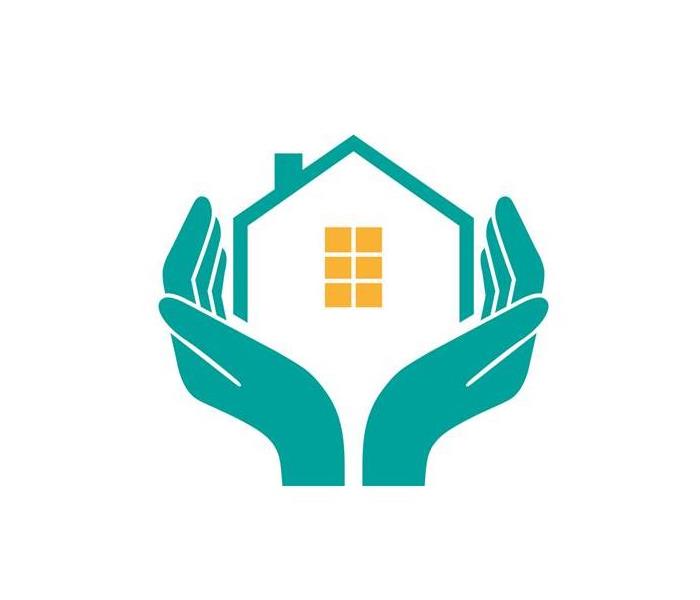 You can trust that your home is in very capable hands with the skilled and highly trained experts at SERVPRO.
You can trust that your home is in very capable hands with the skilled and highly trained experts at SERVPRO.
SERVPRO Assesses the Fire Damage and Formulates a Plan for Restoration of Your Lockport Home.
While there are several ways to handle the cleanup after a fire in your Lockport home, calling in the help of IICRC-certified technicians ensures you get the best results. At SERVPRO, we have highly-trained fire and smoke restoration technicians (FSRT), and We are Faster to Any Size Disaster. This ensures you get help quickly so that your routine may resume faster than any DIY methods could ever achieve.
Our Expert Restoration and Clean Up Process
Once you call us for help with cleaning up fire damage in Lockport, our team arrives to begin the assessment process. A few of the mitigation efforts that occur shortly after our initial scoping of the project will include:
- Removal of charred debris and unsalvageable building materials and contents
- Total surface cleaning
- Dry vacuum methods
- Water extraction to handle moisture left after extinguishing the flames
- Soot and ash removal
What Can I Do About the Awful Odors?
With any house fire restoration project, deodorization is critical. Even with the smallest fire, odor molecules can leave a lingering reminder of the blaze. Burning odors and smoke residue can intensify without proper mitigation practices, such as surface cleaning and debris removal. Once we handle the initial cleanup, our SERVPRO crew utilizes a range of deodorization techniques while using equipment such as:
- Thermal fogging technology
- Hydroxyl generators
- Odor neutralizing pellets
- Ozone generators, and more
Should there be a great deal of smoke and soot throughout your HVAC system, our team utilizes sealants to limit the spread of odor-causing particles. We also use sealants on walls to keep lingering odors from becoming a reminder of the fire incident.
SERVPRO of Eastern Niagara County is available 24 hours a day if you are faced with fire damage to your home. You can reach us by calling (716) 694-7776, and we send out a team as soon as possible.
Find out more about Lockport.
Is There One Best Way to Restore Lockport Fire Damage?
8/6/2020 (Permalink)
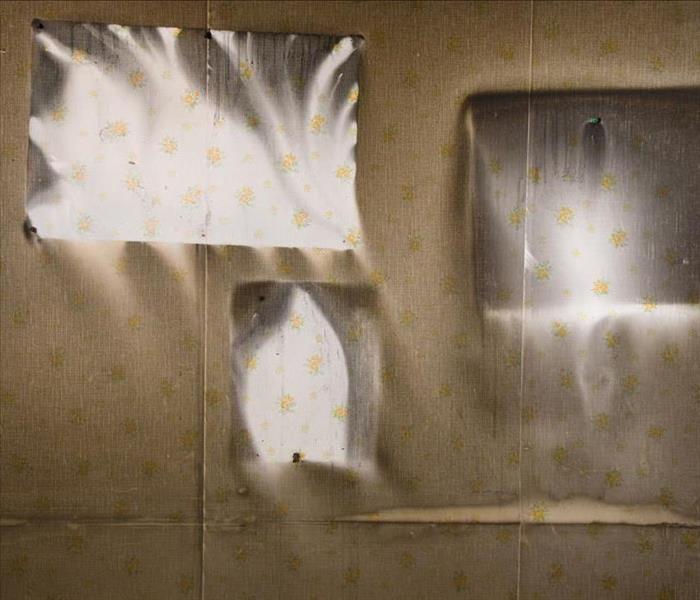 Trust SERVPRO to Resolve Your Smoke and Soot Stained Lockport Home--"Like it never even happened."
Trust SERVPRO to Resolve Your Smoke and Soot Stained Lockport Home--"Like it never even happened."
Variants in the Smoke and Soot Characteristics Presenting During Lockport Residential Fire Damage Restoration Resolve Well When SERVPRO Professionals Are on the Job
One-size-fits-all cleanup approaches are popular for busy Lockport homeowners, limiting the products chosen in anticipation of routine housekeeping and occasional messes. A fire loss calls this attitude into question. If you decide to try to manage all the cleaning yourself or even pick out a few tasks to get out of the way before the professionals arrive, unfortunate circumstances are likely. If the professional evaluation and cleaning adaptations are not made, restoration fails.
Why Is Planning Fire Damage Restoration Such a Puzzle?
Lockport residents who feel the restoration of fire damage is merely another maintenance task are probably coping with their first smoke and soot cleanup emergency. The residues created when building materials and contents are unique and pose significant challenges to resolve. An all-purpose cleaner and a sponge can spread and smear the soot, failing to remove the residues adequately and exposing the structures and contents affected to the risk of corrosive damage.
The possibility of skin contact with or inhalation of potentially toxic substances also can pose health consequences. Different fuels in different parts of your home create smoke and soot residuals that vary widely and require individualized interventions even within the same room. Strategies to eliminate these residues must reflect this reality.
Who Can Assess Residues and Match Them with Effective Fire Restoration Methods?
SERVPRO ensures our work crews have the knowledge and skills offered by training through the Institute of Inspection, Cleaning and Restoration Certification (IICRC). Standards developed by this international organization are research-based and evolve as innovations improve the options available. We use this knowledge base to craft a restoration plan that:
- Links residues to cleanup methods and products proven scientifically to work
- Enforces the use of safety controls including personal protective equipment (PPE) for our workers and containment of the workspaces to shield you and your family from hazards
SERVPRO of Eastern Niagara County has a trained workforce, proprietary cleaning products, and specialized equipment needed to achieve successful fire damage restoration. Partner with our highly-qualified team by calling (716) 694-7776.
What Can I Expect from Professional Fire Damage Restoration in Lockport?
7/16/2020 (Permalink)
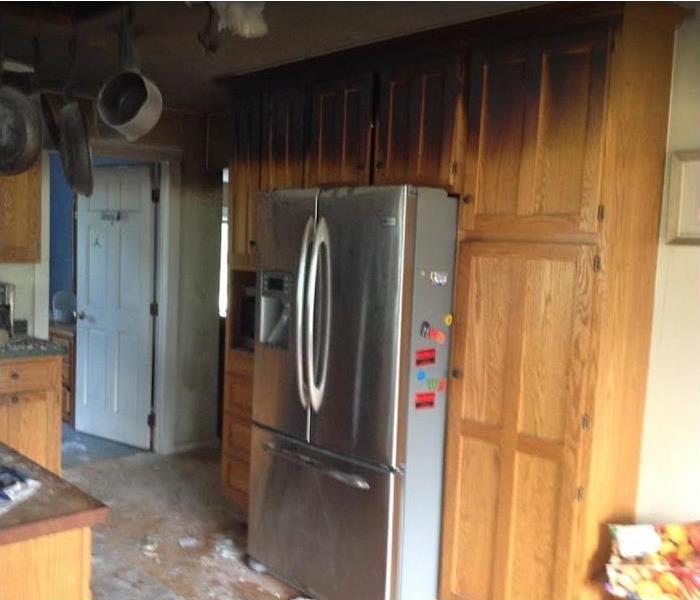 Fires happen and are one of the most stressful events for homeowners. Call SERVPRO for fast remediation.
Fires happen and are one of the most stressful events for homeowners. Call SERVPRO for fast remediation.
Trust that Your Property is in Trained and Experienced Hands When the SERVPRO Team Arrives to Restore Fire Damage at Your Lockport Home
Fire damage restoration is uncharted territory for the typical Lockport homeowner. The fire and its aftermath are hard to respond to constructively if you have no previous context for what the process will be like or how long a restoration effort might last. It does not help you feel pressured to shorten the time taken to weigh the pros and cons of various approaches or choose among different disaster recovery companies. Finding a disaster recovery firm you can trust is the foundation for the best possible outcome.
Why Is a Professional Response to Fire Damage So Essential?
After being tasked with arranging for fire damage restoration in your Lockport home, the job feels overwhelming. One of the most constructive things available to bring your stress and anxiety under control is to partner with our Institute of Inspection, Cleaning and Restoration Certification (IICRC)-trained workforce. Once you hear and see the confidence our managers demonstrate during the evaluation of your fire scene, you realize we can deliver on the promise of making the damage, "Like it never even happened." Collaborating with our team lowers your stress and allows you to manage the rest of your and your family's disrupted lives.
Is It Typical for Restorers to Begin Implementing Water Mitigation Tasks Immediately?
Unlike many other home maintenance or improvement projects that go through a bidding, awarding, and waiting process, when the SERVPRO team arrives and is given the go-ahead after a safety review, some of the interventions begin within minutes to hours. The progressive nature of fire damage is well-documented, with permanent harm occurring right away and worsening. Successful restoration is most likely when trained technicians begin best practices as soon as practical. We know this might feel rushed, but we assure you we are following well-established and research-based protocols, the implementation of which we are familiar and experienced in doing even though it is all new to you. Examples of actions to halt the damage and begin remediation can include:
- Removal of firefighting water and extinguishing chemicals
- Disinfection and structural drying of wet areas
- Containment of work areas with 1.6 mil polyethylene and sealing by negative pressure air scrubbing equipment to reduce airborne particulates lower the smoke odor load
- Moving of contents to a non-affected space on your property, or a recommendation to pack-out furnishings, household items, and a range of other personal possessions to our production facility
- Cleanup of charred and otherwise damaged debris
- Inspection of HVAC systems
- Walkthrough of every space in your home, as fire residues disperse and float on super-heated air currents to deposit on any available surface
- Evaluation of the soot and surface characteristics of soiled surfaces, matching the residues and their resting places with the products and techniques science and experience suggest work most effectively to clean, sanitize, and restore
- Implementation of the residue removal plans indicated by the evaluation
Why Do Restoration Technicians Wear Protective Equipment?
Some of the most disconcerting after-effects of a Lockport household fire are warnings that your comfortable home has transformed into a hazardous environment. A primary reason experts discourage DIY restoration of fire damage is the residues' toxic nature, both airborne and settled onto surfaces. Our technicians use various personal protective equipment (PPE) to avoid skin contact with dangerous residues and minimize the inhalation of potentially unhealthy airborne particles and aerosols. The procedure used to don and remove the PPE protects you and your family from the toxic residues as it prevents tracking the hazards into areas of your home you might still inhabit during the project.
Are There Ways Restoration Companies Help with Insurance Concerns?
Restoration of your home after a fire event involves expenses, most of which you hope to find coverage from your home insurance policy. Documentation must be complete and convincing for the damage done to your home's structure and contents. We pledge to work closely with each residential customer and insurance carrier to ensure the data needed to substantiate claims is in place. Transparent communication is crucial, and we keep you informed and welcome concerns and questions now and into the future.
You can rely confidently on the highly qualified and experienced managers and crews of SERVPRO of Eastern Niagara County when they respond to your fire restoration request. Our lines answer 24/7 at (716) 694-7776. We're Faster To Any Size Disaster.
Fire at Church
5/1/2020 (Permalink)
This church in Buffalo, NY suffered damage from a fire . A group of vandals had set garbage cans on fire outside the church. There was extensive damage to the outside of the building .
When our crews arrived at the scene , we noticed the smoke damage. There was some smoke that came through a window that was cracked in the hallway, due to the vandalism. The smoke smell was smelt through out the church. The crews properly cleaned the kitchen, common hallways and entry areas.
The vapor shark was used to help alleviate the odor.
Whether your residential or commercial property has suffered a fire , please give us a call. We can provide you with an estimate, approximate price on what needs to be cleaned . Faster to any disaster ! 694-7776.
Fire in Back Bedroom
2/6/2020 (Permalink)
We responded to a fire in a the customers home in North Tonawanda. The fire was the result of faulty wire connecting the TV to the power outlet. The customer had a lot of content in the room, in which was all affected by the smoke.
Our crews were called to the scene to assess the damage and plan for what needed to be done. When the scene was cleared , our crew began their clean up. We removed any non-salvageable debris from the scene. We HEPA vacuumed any webs created from the smoke. We then hand wiped all walls, ceiling, floors and content with SERVPRO cleaning and deodorization products. Through the whole process, we ran two Vapor Sharks to properly removed the odor form the air. Any carpets and upholstery were cleaned at the end of the process were professionally cleaned.
The customers pleased with the job that was done. SERVPRO of Eastern Niagara County is here to help you with your fire and water damage clean up needs. Please give us a call at 694-7776.
House Fires
2/5/2020 (Permalink)
Fire in ones home or business can be extremely stressful. SERVPRO of Eastern Niagara County is here to help make your process smoother .
We will come to your home/ business and asses the damage . We will see what needs to be done . We will give the customer the approximate cost of the clean up and restoration . SERVPRO of Eastern Niagara County believes in giving the customer the estimate before the job is started . Our crews are professional and properly trained . We are here for you! Give us a call at 694-7776. We have been serving Niagara County and it’s surrounding areas for the past 19 years .
Here are the 8 most common fire hazards in the home
11/1/2019 (Permalink)
1. Candles
Who doesn’t love the romantic glow of candlelight? But, even if you enjoy their fragrance and ambiance, you might want to think twice before lighting a candle and leaving the room. From 2007-2011, the NFPA says there were an average of 10,630 fires in the U.S. that were started by candles, causing 115 deaths, 903 injuries and approximately $418 million in property damage. That is an average of 29 candle fires per day.
About one-third of these fires started in bedrooms, causing 39% of the associated deaths and 45% of the associated injuries. More than half of all candle fires start because of candles that were left too close to flammable items. They should always be kept at least 12 inches away from anything that can burn.
2. Smoking
While the number of fires caused by smoking is trending downward, the NFPA found that there were still an average of 17,600 related fires per year resulting in 490 deaths and more than $516 million in property damage.
3. Electrical & Lighting
Electrical fires can have a number of different origins. They can be caused by an equipment malfunction, from an overloaded circuit or extension cord, or from an overheated light bulb, space heater, washer, dryer or other appliance.
According to the NFPA, in 2011 approximately 47,700 home structure fires were caused by some sort of electrical failure or malfunction. These resulted in 418 deaths, 1,570 injuries and $1.4 billion in property damage.
4. Dryers and washing machines
Clothes dryer fires happen more often than one might think, accounting for 16,800 home structure fires in 2010 and doing more than $236 million in property damage. The most frequent causes of fires in dryers are lint/dust (29%) and clothing (28%). In washers, they are wire or cable insulation (26%), the appliance housing (21%) or the drive belt (15%).
5. Lightning
Unlike other types of house fires, which occur more frequently in the winter months, those caused by lightning are more likely to happen in June, July and August in the late afternoon or early evening. From 2007-2011, NFPA says there were an average of 22,600 fires per year caused by lightning strikes.
6. Children playing with fire
The NFPA says that children start an average of 7,100 home fires per year, causing approximately $172 million in property damage. July is the most active month for these fires, and males start the majority (83%) of them. Younger children under the age of six are more likely to start fires inside, using matches or a lighter as the ignition source. The most frequent sites for fires are the bedroom (39%), kitchen (8%) and living room/family room/den (6%). Older children are more likely to start fires outside.
7. Christmas trees
Like candle fires, Christmas tree fires are more common during the holidays, with 43% occurring in December and 39% in January. The NFPA says an average of 230 fires are attributed to Christmas trees each year and they are more likely to be serious because of the factors that can contribute to the fire: a dry tree, electrical lights and a fuel supply (gifts) under the tree. Christmas tree fires cause an average of $18.3 million in property damage each year.
8. Cooking
The number one source of house fires is cooking – usually leaving pots or pans unattended on the stove while you run away to do something for “just a minute.” The NFPA says that 40% of all house fires, or an average of 156,600 per year, start this way, causing approximately $853 million in property damage. Two-thirds of the fires started because the food or other materials caught fire.
Fires are more likely to start on a range (57%) as compared to the oven (16%), mainly due to frying. Most injuries occur when the cook tried to put out the fire.
Several years ago in Florida, investigators saw a pattern of fraudulent house fires that started in the kitchen when the owners left food cooking on the stove while they ran to the store for a missing ingredient. Grease would catch on fire and the flames spread from there.
We are here to help with your fire damage clean up and restoration needs . We have been serving Niagara County and it’s surrounding areas for the past 19 years . Give us a call 716-694-7776 . We would be happy to be of assistance .
House Fires
10/11/2019 (Permalink)
House fires are caused by a number of things, such as lightening, brush fires, electrical shorts, candles, fireplaces, heaters and more. Fire damage is often doubled with water damage due to the fire fighters efforts to extinguish the flames.
Home fires are dangerous. The best precautions to take are having a plan in case of emergencies and having working smoke detectors in the home. A plan needs to be in place of how each person will get out of the house and where to meet in the event of a fire.
Fire is fast and deadly. The smoke is just as dangerous as the flames. Once you are outside of your home during a fire, NEVER re-enter the home. The smoke will make it hard to see and breathe. Wait for the fire department to do what they are there to do.
Should you experience a fire damage, give us a call. We are #HereToHelp.
We are here to help with your fire damage clean up and restoration needs . We have been serving Niagara County and it’s surrounding areas for the past 19 years . Give us a call 716-694-7776 . We would be happy to be of assistance
Kitchen Fire
8/21/2019 (Permalink)
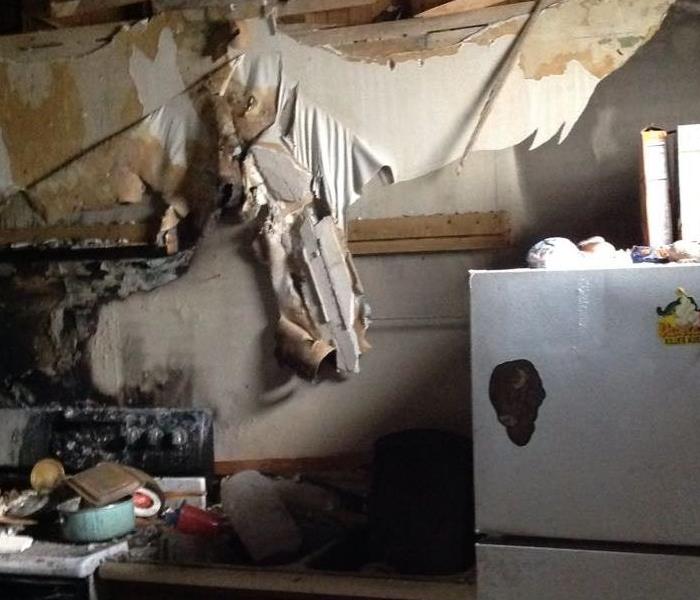 Kitchen Fire : Pre- Mitigation
Kitchen Fire : Pre- Mitigation
Aside from calling 9-1-1, which should be one of your first moves, here are some quick tips for dealing with a fire emergency in your kitchen.
- Always watch your cooking; don't leave anything unattended
- Set a timer so that you don't accidentally burn something or forget that an appliance is being used
- If something on the stove catches on fire and it is small, cover it with a lid and turn off the burner
- Keep a fire extinguisher in the kitchen near your cooking area where it is easily accessible
- Add baking soda to a grease fire, not water
- Clean your appliances regularly so that grease does not accumulate and start a fire
- Clean and dust around and behind appliances, as dust accumulation can cause fires if it is close to electrical wiring
- Keep flammable objects away from cooking appliances, especially those things like tea towels and potholders
- Install a smoke alarm in your kitchen
- Test your smoke alarms and make sure they will work when you most need them!
Keep these quick tips in mind, and prevent a major fire damage emergency from taking place in your home this season!
We are here to help with your fire damage clean up and restoration needs . We have been serving Niagara County and it’s surrounding areas for the past 19 years . Give us a call 716-694-7776 . We would be happy to be of assistance
Grilling Safety this summer
7/11/2019 (Permalink)
Summer is the time for picnics, barbeques and plenty of delicious food; however do you know all of the safety measures you should take with your grill? Three out of five households own a gas grill. Each year an average of 8,900 home fires are caused by grilling and about 16,000 patients went to the emergency room because of an injury involving a grill. Wow, that’s a lot.
Most of these injuries and fires could have easily been avoided. So just in case, here are some tips on how to avoid injuries and fires while also enjoying those yummy summer-time meals:
- Keep your grill away from your home and deck railings.
- In order to safely turn on your grill, follow these steps:
- Open the lid before turning on the grill
- Turn on the propane tank
- Turn on the knobs of the grill burner
- Push ignition button (if you have one)
- If your grill doesn’t ignite, let gas dissipate for at least 5 minutes before igniting again.
- To turn off your grill safely, turn the gas tank off first in order to keep excess gas from leaking out.
And in case of fire damage, you know who to call: SERVPRO! 694-7776
Fire Damage
4/30/2019 (Permalink)
Fire damage is probably the last thing on your mind, but you may want to move it up on your list of priorities; preparation is the key. The first 48 hours after a fire often makes the difference between ‘restoring’ vs. ‘replacing’ your property and personal belongings. SERVPRO of Eastern Niagara County provides a timely response with mitigation services ranging from fire, smoke and soot removal, to content claims inventory and document restoration. Here is a timeline to help ease your mind of what should be done before and after SERVPRO of Eastern Niagara arrives:
- One Hour: Within one hour from notice of loss, a SERVPRO of Eastern Niagara County professional will contact you to arrange for service.
- Four Hours: Within four hours of loss notification, a SERVPRO Eastern Niagara County of technician will be onsite to start mitigation services.
- Detailed Explanation: A trained and uniformed SERVPRO of Eastern Niagara County employee will walk you through the job process step-by-step, explaining what to expect and the anticipated outcome.
- Pretesting: A SERVPRO of Eastern Niagara County employee will begin pretesting for restoration, working from the source of the damage outward.
- Eight Hours: Within eight business hours of on-site arrival, a verbal briefing of the scope is communicated to the appropriate person.
- Cleaning, Restoration, & Deodorization: SERVPRO of Eastern Niagara County will work neatly and efficiently to help you regain control of your property. We then use state-of-the-art restoration techniques to make it “Like it never even happened.”
- Final Walk-through: After the work has been completed, a final walk-through will be conducted with you to help ensure your satisfaction.
SERVPRO of Eastern Niagara County responds quickly, offering a full line of fire cleanup and restoration services to help you return home as soon as possible. Before risking further damage by attempting to clean up the damage on your own, call the fire damage clean up and restoration professionals at (716) 694-7776.
Fire Damage : Process of Restoration
4/2/2019 (Permalink)
Fire Damage in Lockport NY Smoke Damage in Lewiston,NY , and Restoration, and the Process of Fire Restoration,
The process of fire restoration can be very involved. Private homeowners and companies can oftentimes be devastated by the damage caused by this kind of event. One aspect that gives peace of mind involves knowing when the right professional has been hired. That is one of the reasons why it is important to hire a firm that is associated with the Institute of Inspection Cleaning and Restoration Certification.
Homeowners and business owners may be in shock from the initial devastation. It is important to try and follow the proper steps to achieve a complete fire restoration. Service providers that are associated with the Institute will have the following distinctions: current training, safety and health certifications, vast amounts of experience in restoration projects and the proper licenses and insurance information. Customers should also check all references and obtain price quotes prior to hiring anyone. Any contracts that are presented should be reviewed closely.
The first step in the process is to clean up as much of the existing area as possible. If the area is not immediately cleaned, soot residue and permanent damage can be left behind. If the homeowner or business owner does the initial cleaning, it is important to follow these steps. When cleaning, always use dust masks and open the area for proper ventilation. Clean from the ceilings to the floors and vacuum all floors and upholstery. Wash any items that are able to be laundered. Clean the outside with a pressure washer if available.
If immediate clean up is not done, it can lead to devastating effects. Within minutes of fire and smoke damage, appliances and many items will discolor to a yellow hue. After a few hours, acid will stain bathrooms and many other areas of the home or business. Within days, walls will discolor permanently and items will begin to rust due to the acid residue. Finally, after weeks the cost of clean-up will become substantially more expensive. The building and furnishings can be permanently damaged by the acid left behind. Soot residue will be layered throughout the home or business. For these reasons, it is vital to contact a professional associated with the Institute of Inspection Cleaning and Restoration Certification to utilize fire restoration techniques in an effort to return the home or business to a preloss state. One company or service provider should be able to handle the damage. The seal of Certification by the Institute should be shown on any provider’s website. This shows the customer the reliability and the expertise of the service provider.
Residue and smoky odors need to be removed immediately. Professionals will use the process of fire restoration to achieve satisfactory results. These providers will remove the source of the odor, clean any items that can be salvaged, get rid of any lingering odor with an odor counteractant and deodorizing fog. Finally, the provider will seal salvageable items to encapsulate odor and prevent further recontamination.
Homeowners and businesses that are educated in the fire restoration process are able to minimize the cost of repair. Professionals can be contacted in a timely manner to return the area to a preloss state. By hiring the right professionals the victims can have some peace of mind during a very stressful time.
We are here to help with your fire damage clean up and restoration process : 694-7776
Fire & Smoke Damage in Kitchen
3/2/2019 (Permalink)
Every 90 seconds a residential or commercial fire occurs in the US. Fire and smoke damage in any sort of structure has hidden damage and odors. A fire loss is very complex because of the unique behavior of smoke.
Our Fire specialists here at SERVPRO of Eastern Niagara County have the experience and expertise to take care of any fire damage you may have no matter how big or small it might be. Special losses require special care, and we understand that caring for them is your first priority. SERVPRO of Eastern Niagara County is always available 24 hours a day 365 days a year for you Fire loss.
Have Questions about Fire, Smoke, or Soot Damage? We would be happy to help !
Call us today- (716) 694-7776
Commercial Fire and Restoration
2/19/2019 (Permalink)
Commercial Fire and Restoration
Fire damage can be very devastating for a business or commercial property. In addition to fire, smoke, and soot damage, water damage caused by firefighting efforts and fire suppression systems may occur. Every hour spent restoring your business back to pre-fire condition is an hour of lost revenue and productivity. If you have a fire emergency, call a SERVPRO of Eastern Niagara County Professional.
- 24 Hour Emergency Service
- Faster to Any Size Disaster
- A Trusted Leader in the Fire and Water Restoration Industry with over 1,700 Franchises
- Highly Trained Fire and Water Damage Restoration Specialists
Commercial Fire Damage? Call Us Today 716-694-7776
Commercial Restoration Presents Unique Challenges
SERVPRO of Eastern Niagara County Professionals have the training, experience, and equipment to manage your commercial fire damage emergency. They will respond quickly and manage the fire restoration project through to its completion—getting your property business-ready.
- Fire and Smoke Restoration Technician
- Odor Control Technician
- Upholstery & Fabric Cleaning Technician
- Water Damage Restoration Technician
Have Questions About Fire, Smoke, or Soot Damage?
Call Today 716-694-7776
9 Facts about Fire
1/7/2019 (Permalink)
1. Understand the fire triangle
A simplified cousin to the fire tetrahedron, the triangle represents the three components that fires need to exist: heat, oxygen and fuel. If one of these components is missing, a fire can’t ignite.
Heat can be generated by a cigarette, an electrical current or a home heater. Fuel can be anything combustible, such as wood, paper, clothing, furniture, gases or chemicals.
Once a fire starts, if any of the three components is removed, the fire is extinguished. Water is used to cool a fire and take away the heat source. Oxygen can be removed by smothering a fire with dirt, sand, a chemical agent or a blanket.
Fuel can be removed by moving combustible materials away from the fire or by simply waiting until the fire consumes the material and goes out of its own accord.
2. Fire kills
Every year more than 3,800 people die fire related deaths in the U.S. Approximately 18,300 people are injured every year in fires. Most of these fires could have been prevented by practicing proper fire safety and having fire alarms. On average more than 60 firefighters die every year in the line of duty.
3. It's in the kitchen
Most house fires start in the kitchen. Cooking is the leading cause of home fire injuries. Cooking fires often start from overheated grease and unattended cooking. Electric stoves are involved in more fires than gas stoves.
4. Leading causes of death
Another fact about fire is that smoking is the primary cause of death by fire in the U.S. The second cause of fire deaths is heating equipment.
5. Arson
Arson is the third most common cause of home fires. Arson in commercially operated buildings is the major reason for fire deaths and injuries in those types of properties.
6. Smoke inhalation
More people die from smoke inhalation than flames. Fire can suck all of the oxygen from a room and replace it with poisonous smoke and gases before flames even reach a room. Many times people die from lack of oxygen before the fire reaches their room.
7. Run report
According to NFPA, firefighters in the U.S. were called out on 501,500 structure fires in 2015. Between 2007 and 2011, there was an average of 2,570 civilian deaths and 13,210 civilian injuries per year, and a total estimated cost of $329 billion in 2011.
8. Candles
Candles caused approximately 9,300 home fires and 86 home fire deaths between 2009 and 2013.They were also responsible for 827 injuries and $374 million in property damage.
9. Smoke alarms
Approximately two-thirds of all fire deaths happen in homes where there’s no working fire alarm. Your chance of dying in a home fire is cut in half if you have a working smoke alarm.
https://www.firerescue1.com/fire-products/Firefighter-Accountability/articles/1206336-9-facts-about-fire/
SERVPRO of Eastern Niagara County is here for all of your restoration needs
Cleaning After Fire
1/7/2019 (Permalink)
Cleaning After Fire
The October 2017 California Fires in Northern California were devastating. Northern California will be dealing with the death and destruction of recent wildfires for years. The immediate life-safety concerns about fire are obvious and frightening, but what many don’t realize is that returning to fire damaged buildings is also hazardous. Cleaning after fire is part of recovery, but done wrong this activity may do more harm. If you’re returning to a fire damaged community follow these fire restoration tips to reduce your health risks.
After you have dealt with the initial raw emotions of fire loss, after you have contacted your insurance company and relatives and emergency personnel that are worried about you, it is time to cleanup and rebuild. FEMA has a checklist for “returning to normal” after a fire. If hiring professionals is not in the budget or you want to get back home before the pros show up, read these tips for cleaning after a fire.
Immediate Threats When Cleaning After Fire
These basic measures may save your life when you return to cleanup after a fire.
- Do not reenter a fire stricken area or building unless a professional has verified it is safe to enter. Fires may reappear and you don’t want to be stuck in the danger zone. Do not go around police/fire barricades or ignore evacuation orders.
- Do not approach downed power lines or attempt to work around electrical wires.
- If the structure has been significantly impact and there are any concerns about the structural integrity of the building, do not enter until an expert or structural engineer okays the building.
- Do not enter areas with standing water. There may be hidden dangers in the water.
- Hire a professional fire restoration company – if you can. Here is a checklist for hiring a contractor after a fire. Talk to your insurance first.
https://healthybuildingscience.com/2017/10/18/cleaning-after-fire/
SERVPRO of Eastern Niagara County is here 24/7 365 for all of your restoration needs
Candle Safety
12/28/2018 (Permalink)
Many homeowners light candles to freshen up a room or to have lighting during a power outage. However, candles still have the potential to create a fire that spreads throughout the building. Avoid a candle fire at all costs, and follow these helpful tips to stay safe.
1. Do Not Leave Candles Unattended
If you are leaving a room with a candle in it, first extinguish the flame. After all, you can always relight a candle if you desire.
2. Keep the Area Around Candles Clean
The shelf or stand where you place the candle should not have anything flammable on it. Additionally, you should avoid placing a candle on a nightstand near your bed. The bedding may catch fire if you are not careful.
3. Toss It Once It Is Less Than Two Inches Tall
You do not want to risk a candle fire by allowing the flame to get too close to the base of the candle. It is better to simply throw away a candle once it is less than two inches high. They are relatively inexpensive to replace.
4. Keep Candles Away From Pets and Children
Candles should be placed high enough that kids and animals cannot get them. It is dangerous for children to play with anything lit. If the candle is left on a coffee table, then a dog’s tail may accidentally hit it and cause it to fall onto the floor.
5. Do Not Put Out a Candle With Water
It is preferable to put out a flame by blowing on it rather than pouring water. The reason is that water can cause the wax to spill all over the place. The hot wax may still catch fire, causing flames to spread throughout a home in Brooklyn NY. Candles are meant to be enjoyed, so always follow the manufacturer’s safety instructions to avoid a nasty candle fire and the impending smoke cleanup.
Don't let your Christmas Tree Dry out
12/20/2018 (Permalink)
For many folks in last weekend included putting up the Christmas Tree. This is a festive time of year, but also a time to remember some safety tips.
At SERVPRO we rely on the National Fire Protection Association for key fire safety tips. They recommend the following:
- Keep tree at least 3 feet from a heat source
- Be sure to add water to tree daily
- Make sure lights are not broken or have frayed cords
- Turn off holiday lights before bed or when leaving the home
Most importantly is to get rid of the Christmas tree once it is dried out. Removing the dead tree from the home and garage is the best prevention for accidental holiday fires.
SERVPRO of Eastern Niagara County will be available all holiday season to assist with any smoke, fire or water damage needs. Call 716-694-7776
Christmas Holiday Safety
12/20/2018 (Permalink)
The Christmas season is in full swing. During this time each year, the traditional Christmas tree fills the family room surrounded by presents. BE CAREFUL - Christmas tree fires are infrequent, but they can happen. Listed below are a few good measures that will help ensure your home’s safety:
• Make sure you pick a healthy tree; trees with brown needles indicate dryness.
• Make sure your tree is placed in a sturdy stand to prevent it from falling over.
• Make sure your stand has an adequate basin for water.
• Make sure to check and water your tree daily.
• Check your lights to make sure they are fire resistant and supported by a national testing organization.
• Keep your trees a safe distance from any heat source.
• Make sure that the lights and any extension cords used are in good working condition; look for and replace damaged wires.
• Check all the bulbs to make sure they are working properly.
• Make sure you have adequate smoke alarms in the area and they are working properly.
The SERVPRO of Eastern Niagara County team wants to ensure that everyone has a safe and joyous season. In the unlikely event that a fire were to occur, know that the SERVPRO team is ready to assist 24/7 by calling 716-694-7776
After a Catastrophic Fire, Identify All of the Damage
11/30/2018 (Permalink)
If your business has been affected by a fire, it is important that you identify both fire damage and water damage when getting back on your feet. Determining the losses from both the flames and the fire hose water can save your business time and money when returning to business.
What Did the Fire Affect?
Visible signs of damage can range from soot and charring to smoke stains and discoloration. Make sure to go office by office, room by room and location by location to determine what has been burned as well as what has been otherwise impacted by the blaze. A variety of specific areas will likely require attention:
- Floors, walls and ceilings that have been burned, charred and stained
- Areas that have residual smoke odors, such as carpeting, cubicle walls and office furnishings
- Electrical wires, cables, conduits and plumbing fixtures that could have been destroyed, weakened, melted or suffered other heat-related fire damage
- Office equipment, computers, telephone systems, server rooms and manufacturing equipment that was directly in the line of fire or affected by smoke, ash and soot
- Sensors, tools and small appliances that can require recalibration or cleaning
What Did the Fire Hose Affect?
When extinguishing a fire, first responders use a lot of water to put out the flames and embers. When water is introduced to parts of your business that have never been wet, the effects can slow your recovery if you don't analyze everything promptly.
After the firefighters leave, ponding water and puddles are obvious. However, moisture in cabinets, closets and files can be easily missed. If it is left standing or stagnating in a warm area, water damage and subsequent mold and mildew growth can spread quickly. Additionally, wet ceiling tiles that sag are a danger for employees if they become too heavy and start crashing down. Make sure to also check storage tanks to ensure condensation has not contaminated the contents.
When addressing water and fire damage , be sure to find the right commercial building restoration service that can correct all of the damage and get you back in business as quickly as possible.
Christmas Tree Fire Safety
11/30/2018 (Permalink)
No one wants to spoil the holiday season, but Christmas trees in the home can present a fire safety issue. A primary concern with a Christmas tree is fire danger, often brought on by the combination of electrical malfunctions and, in the case of a real tree, a drying tree.
In the United States, Christmas trees start approximately 210 house fires per year.
According to a National Fire Protection Association (NFPA) report issued in 2015, U.S. fire departments responded to more than 200 home structure fires annually between 2009 and 2013 in which Christmas trees were the first item to catch on fire. Each year, fires occurring during the holiday season injure 2,600 individuals and cause over $930 million in damage, according to the United States Fire Administration. Sadly, Christmas tree-related fires have a higher incident of fatalities than typical house fires, according to the NFPA report.
Electrical malfunctions are often to blame for Christmas tree fires.
Electrical failures or malfunctions were involved in nearly half of the fires, igniting the tree with sparks or small electrical fires. Decorative lights with live voltage were involved in more than 20 percent of the instances. However, putting trees too close to open fires or heaters caused a significant number of fires as well: nearly a quarter occurred because a heat source was located too close to the tree.
It isn’t just real trees that are a problem. Electrical malfunctions can also ignite plastic artificial trees, and homeowners should take the same precautions in terms of tree placement and decorations as they would with a real tree.
Be careful with how you discard your tree.
You should take care with trees that are left outside as well. The NFPA report revealed that an annual average of 90 outside and other non-structure fires on residential properties occurred because of Christmas trees stored on the property, the report indicates. Two-thirds of these fires occurred in January, with 64 percent of them being set intentionally. This suggests that discarded Christmas trees may be an attractive target for arsonists.
But, arson concerns are not an excuse to leave your tree up after the holidays. According to the NFPA, even a well-watered tree should be taken down within four weeks of being brought into the home. If you decorated your real tree right after Thanksgiving, it should be discarded the week after Christmas, not New Year’s Day. This is because by the end of the holiday season, Christmas trees are extremely dry, and present a heightened fire hazard.
ACTA (The American Christmas Tree Association): http://www.christmastreeassociation.org/christmas-trees-and-fire-safety/
Picture taken from Today.com
Thanksgiving Fire Safety
11/18/2018 (Permalink)
Tips to Cooking Safely this Thanksgiving!
Millions of people are starting to get ready for the Thanksgiving holiday. It's a great time to spend with family and friends, and is also a time when cooks spend a lot of time in the kitchen. Below are a few tips from our partners at the American Red Cross so you can use to avoid a cooking fire while whipping up Thanksgiving dinner.
Thanksgiving by the numbers
- Thanksgiving is the peak day for home cooking fires, followed by Christmas Day and Christmas Eve.
- In 2015, U.S. fire departments responded to an estimated 1,760 home cooking fires on Thanksgiving, the peak day for such fires.
- Unattended cooking was by far the leading contributing factor in cooking fires and fire deaths.
- Cooking equipment was involved in almost half (48%) of all reported home fires and civilian and tied with heating equipment for the second leading cause of home fire deaths.
COOKING SAFETY Cooks should avoid wearing loose clothing or dangling sleeves while preparing the holiday meal. Never leave the stove unattended – if the cook has to leave the kitchen even for a short time, they should turn off the stove. More cooking safety steps are:
• Check food regularly.
• Use a timer as a reminder that the stove or oven is on.
• Keep children and pets away from the cooking area.
• Keep anything that can catch fire - pot holders, oven mitts, wooden utensils, paper or plastic bags, food packaging, and towels or curtains—away from the stove, oven or any other appliance in the kitchen that generates heat.
• Clean cooking surfaces on a regular basis to prevent grease buildup.
• Consider purchasing a fire extinguisher to keep in the kitchen.
• Always check the kitchen before going to bed or leaving the home to make sure all stoves, ovens, and small appliances are turned off.
From all of us at SERVPRO of Eastern Niagara County, we wish you a very Happy and Healthy Thanksgiving!
Source: http://www.redcross.org/news/article/Thanksgiving-Safety-Tips
Source: NFPA's Fire Analysis & Research Division
Fire Extinguisher
10/26/2018 (Permalink)
Most commercial owners have a fire extinguisher around.
In fact, most will have more than one in several areas to be safe. The garage, fireplace and kitchen are the most common areas to keep an extinguisher in case of a fire emergency. Even if you own one, you may not know how to use one. Here are the dos and don’ts that fire restoration services want you to know.
1. Do Not Keep a Broken Extinguisher
Always make sure that your extinguisher is up to date. Check for any cracks to the base or hose. You can also lift it up to see if it’s heavy. It should be full of the extinguishing agent and, hence, heavy to the touch. Lastly, a pressure gauge should tell you if the extinguisher is at an operable range.
2. Do Read the Instructions
Keep in mind that every fire extinguisher should have directions printed on it. It should explain the proper way to pull the safety pin, aim at the base of the fire, squeeze the trigger and sweep from side to side to put out the blaze. In a hurry, remember those steps. However, if you have time, you should always read the instructions.
3. Do Not Continue if Fire Grows
In the chance that the fire continues to spread, it’s vital that you know when to stop. The longer you wait as the flames spread through your business, the less chance you have of being able to escape unscathed. You don’t want your route to be cut off by a kitchen fire.
When it comes to using your fire extinguisher, you have to know what you’re doing. Having an extinguisher handy can help you avoid severe fire damage in your home. As long as you use it properly, you can feel a little safer.
General Extending The Life Of A Candle Tips t
10/4/2018 (Permalink)
General Extending The Life Of A Candle
Tips to extend the life of your candle for smell or survival.
We burn candles for a variety of reasons, whether for the aroma or to light the home due to a power outage. Did you know that you could actually assist them in burning longer?
Tip 1: Freeze your candle. Yes, put it in the freezer! By doing so, you are hardening the wax, which makes it melt more slowly and therefore last longer. It may not be feasible to store all of your candles in your freezer, so simply slip your next-up-to-burn candle into the freezer on the morning or night before you’re planning to light it.
Tip 2: After letting the candle burn long enough for a pool of wax to collect around the wick, blow out the flame. Then, quickly sprinkle table salt into the liquid wax. If necessary, use a toothpick to ensure that the salt actually mixes into the wax and doesn’t just sit on the surface. Then re-light the candle. Adding salt serves the same purpose as putting the candle in the freezer—it slows down the rate at which the wax melts, giving you a longer, more economical burn. What matters most is how long you let the candle burn the first time you light it. Try not to extinguish it until the pool of wax has extended across the diameter of the candle. Blow it out too soon, and you may cause the candle to leave excess wax; if it doesn’t melt on the first lighting, the dry, hard wax around the outside edge will almost never burn.
Tip 3: It can also be helpful to keep the candle wick trimmed to about a quarter inch in length, because longer wicks tend to burn faster. Leftover wax is a sign that the candle didn’t burn to its full potential. To get the most bang for your buck, make sure that the candle burns both evenly and completely. Finally, remember not to leave the candle near a door or window or in any similarly drafty spot; not only is such a location unsafe, but it can also result in uneven burning.
Fire damage restoration
10/4/2018 (Permalink)
We’re not going to kid you. Fire damage restoration is tough work. People call SERVPRO of Eastern Niagara County frequently to ask for advice on how to clean up after a fire. Here are seven of the best tips we give people who ask about fire damage restoration.
Most people can put these tips into practice. But remember that fire damage restoration takes time, work, and skill. Realistically consider whether you want to try these ideas on your own or whether you’d be better off hiring highly trained restoration specialists who will guarantee their work.
- Remove Smoke Damage
With any fire you’ll have a degree of smoke damage to your walls, wall paper, and paint. If the smoke damage is not too serious, you should be able to scrub it clean with detergents and bleach. Soot from smoke damage is greasy stuff, so always try to dust as much of it off from a surface before trying to scrub the surface clean. Often, you’ll want to repaint, but make sure all surfaces are clean and dry before you paint.
- Limit Activity & Other Simple Fire Damage Restoration Steps
Until your house is restored, limit your activity and movement in the house. This helps prevent soot particles from being embedded into upholstery and carpets. Keep people’s hands clean so you don’t further soil upholstery, walls, and woodwork. Protect your things by placing clean towels or old linens on rugs, upholstery, and carpet traffic areas. Before you clean know the best cleaning method for that particular cleaning job (one example: Clean and protect chrome with a light coating of petroleum jelly or oil.) Wash both sides of the leaves on your houseplants. Change your HVAC filter and tape double layers of cheesecloth over air registers.
- Get Rid of Mold & Mildew
Firefighters are great. They save many a live and many a home. But they do introduce mold and mildew into houses when they must use water to extinguish the fire. SERVPRO of ENC highly recommends you hire fire damage restoration professionals to deal with mold and mildew. Mold and mildew can cause serious health problems. It’s difficult for a nonprofessional to know for certain if he’s clean up all the areas affected by the mold and mildew. And mold and mildew can contaminate your furniture, carpets, clothing, mattresses, walls, and vents. The best thing you can do immediately is to air out every room and clean out all vents and filters.
- Replace Carpets. Clean And Dry Your Floors
Your floors and carpets end up absorbing the worst of the damage from all the water used to put out a fire. In almost every case, SERVPRO of ENC recommends that you pull up any carpets that have water damage and replace them. Water can also seep underneath vinyl flooring and into the cracks in hardwood. You must address this. If you have experience with flooring, you can lift it up and clean under it. But you may want to call a professional fire damage restoration company to assist you.
- Avoid Smearing Soot Into Clothing
Cleaning smoke damage from clothing is one of the biggest jobs you’ll have after a fire. Make sure you don’t smear the greasy soot into the clothing or just throw the smoky clothes into the wash. Often times dry cleaning is the best bet, and you should ask around local dry cleaners to see if any have experience with post-fire laundry. Removing smoke odor is another issue and we’ve covered it in another blog post.
- Scrub, Soak, And Cleaning Dishes
Dishes are also important items to clean thoroughly after a fire because they will be in contact with your food. Scrub all dishes well, let them soak in a solution of bleach and water (2 tablespoons of bleach per gallon) for at least 20 minutes and scrub some more for safety. When in doubt, if a dish, pot, or pan won’t come clean, cut your losses and throw it out – especially rubber or wooden dishes that absorb smoke.
Help Is Here
The team at SERVPRO of Eastern Niagara County also has specialized training and experience in fire restoration services, natural disaster prevention, water damage, chemical cleanup, and natural disaster cleanup. Call SERVPRO of ENC 716-694-7776 anytime.
Make a Plan
7/19/2018 (Permalink)
Every home should have a fire escape plan. According to the American Red Cross, homeowners shouldn’t just have a plan of escape for a fire but have a plan and practice it twice a year. Home fires cannot be predicted and can happen to anyone. If you’re making preparations to prevent home fire, you should also prepare for what you and your family would do if you have one. Here are some tips from the American Red Cross in making a plan for your home.
- All members of the household should know two ways to get out of every room.
- Consider escape ladders for sleeping areas or homes on the second floor or above. Learn how to use them and store them near the window.
- Pick a place outside for everyone to meet and make sure everyone knows where it is.
- Practice your home fire drill until everyone in the household can do it in less than two minutes.
- Practice waking up to smoke alarms, low crawling and meeting outside. Make sure everyone knows how to call 9-1-1.
- Teach household members to STOP, DROP and ROLL if their clothes should catch on fire.
http://www.redcross.org/news/article/A-Home-Fire-Escape-Plan-Can-Save-Your-Life
Once the safety for your family is established, the next steps to come will be home recovery. SERVPRO® will work with you from widow and roof board up to assisting with the final stages of move back & rebuild.
If you have a fire : SERVPRO of Eastern Niagara County is here to help with fire damage clean up
716-694-7776
When Puff Backs occur
3/14/2018 (Permalink)
Puff Back occurs when your ignition fails to light properly, oil fumes accumulate in the chamber of your furnace. When the pilot light ignites again it causes a small explosion shooting the dust and soot in your ducts or baseboard all over the room. Drapes, blinds, furniture, bedding, clothing, floors, carpets, dishes, appliances, you name it, the soot will manage to find its way in causing major headaches for homeowners.
Soot not only gets anywhere it is so very difficult to clean. It can’t be wiped off with a regular sponge, towel, paper towel, etc. in fact that just makes the problem worse! The cleaning of soot requires special sponges and cleaning products that are used by professionals. Almost worse than the mess is the smell that seems to permeate into everything. This odor is difficult to remove and requires the services of a professional to remove as well. A professional certified home restoration company such as SERVPRO of Eastern Niagara County is experienced with handling puff back situations. A puff back can occur in large proportion such as the situation just mentioned or in small proportion, over a period of time. If you notice black soot accumulating on carpet around heating vents or baseboard, or on surfaces inside your home, chances are you are experiencing a small scale puff back.
Hiring a professional like SERVPRO of Eastern Niagara County right after a puff back can save you time and money.
Call SERVPRO of Eastern Niagara County 716-694-7776
5 Steps to Cooking a Safe Super Bowl Feast
2/2/2018 (Permalink)
Next to Thanksgiving and Christmas, this upcoming [unofficial] holiday is one of the most anticipated events of the year! We at SERVPRO of Eastern Niagara County are huge Super Bowl fans and although any of our technicians would throw down a dozen or so Buffalo wings like it’s nobody’s business, we have crews standing by in case your Super Bowl party gets a little too carried away. According to the U.S. Department of Agriculture, Super Bowl Sunday is the second largest day for food consumption in the U.S. after Thanksgiving. Enjoy the big game and stay fire safe with these tips from the U.S. Fire Administration (USFA):
- Keep an eye on what you fry.
- Stand by your pan.
- Turn pot handles toward the back of the stove.
- Wear short sleeves or rolled up sleeves.
- Keep a pan lid or cookie sheet nearby to cover the pan if it catches fire.
SERVPRO Of Eastern Niagara County is here to help clean up after fire : -716-694-7776
Top Causes of Kitchen Fires
12/21/2017 (Permalink)
Kitchen fires are the #1 cause of house fires and injuries to homeowners, so avoiding them is a worthy goal for every household. Taking common-sense precautions can greatly reduce the chance of igniting a cooking fire during meal preparation, and understanding how to avoid these fires is simple and smart. Listed here are several recommendations from the National Fire Protection Association (NFPA).
- Cooking oil, a key ingredient for frying and sautéing, is also a prime cause of sudden stove-top fires. Smart cooks heat oils slowly to the desired temperature, then add food gently to reduce the chance of splatter and flare-up. Keeping an appropriately sized lid next to your pan gives you a means to quickly cover the pan and snuff out sudden flames.
- Good chefs always stay in the kitchen; unattended cooking is a dangerous gamble. Staying in the kitchen, especially when frying, grilling, broiling or boiling, is a smart and obvious way to avoid an out-of-control fire.
- Roasting, simmering and baking foods takes more time. While the likelihood of a fire may seem less, the main culprit is forgetting to check on your meal. Set a timer to remind you to check back every so often, and be sure that any wooden utensils, oven mitts, paper products, dish towels and curtains are moved far away from heat sources.
- Early morning and late evening cooking coincides with the time you may be more tired. Staying alert is staying safe, so be sure you’re not too sleepy or distracted by other tasks. Consuming alcohol can be enjoyable when preparing meals, but it is also a risk that should be minimized if not completely avoided.
- Fight or flight. There is no concrete answer concerning whether it is better to fight a kitchen fire or immediately leave the room, close the door behind you and call for help. If you’re really unsure, take the safest route and call 911 as soon as you and all others can leave the kitchen.
NFPA studies report that 55 percent of the people who were injured in reported nonfatal home cooking fires during 2005-2009 were injured when they tried to fight the fire themselves. One of every four house fires reported in 2007-2011 started with fat or grease, and one of every three fire injuries resulted from these fires.
Source: NFPA’s Fire Analysis & Research Division
What Happens after a Fire
10/2/2017 (Permalink)
Here are some major or minor fire recovery tips for houses and apartments.
A special thank you to the firemen, policemen, industry professionals, lawyers, insurance agents and people who gave us their time, insight and real-life advice.
- Be safe, be smart.
- Depending on the damage, the fire department may allow you to take your personal belongings (clothing, - jewelry, important documents). If you remove anything, you may have to fill out a form with the fire department listing each item. You will not be allowed to take certain items (i.e. couches, TVs, computers, appliances) as they may have caused the fire.
- If your car is burned or very damaged by debris, do not start it or move it. Fire officials will tell you when you can move your car.
- Ask an on-site fire official for a fire department contact in case of questions after the fire.
- Ask for the approximate date and time for the initial walk-through of your property. For safety purposes, you MUST- be escorted; this is especially true if there is structural damage.
-http://www.whathappensnow.com/getHelp.cfm?cat=2&sub=2
October is Fire Prevention Month
10/2/2017 (Permalink)
About Fire Safety & PreventionDid you know that if a fire starts in your home, you may have just two minutes to escape?The most effective way to protect yourself and your home from fire is to identify and remove fire hazards. 60 percent of house fire deaths occur in homes with no working smoke alarms. During a home fire, working smoke alarms and a fire escape plan that has been practiced regularly can save lives. Fire Safety Tips -Talk with all household members about a fire escape plan and practice the plan twice a year.-Test smoke alarms once a month, if they're not working, change the batteries.-If a fire occurs in your home, GET OUT, STAY OUT and CALL for help.-Install smoke alarms on every level of your home, inside bedrooms and outside sleeping areas.
Preparing and Preventing a Home Fire - Steps You Can Take Now
-Keep items that can catch on fire at least three feet away from anything that gets hot, such as space heaters.
-Never smoke in bed.
-Talk to your children regularly about the dangers of fire, matches and lighters and keep them out of reach.
-Download the Monster Guard: Prepare for Emergencies mobile game to teach kids about fire safety and other disasters.
-Turn portable heaters off when you leave the room
Smoke Alarms
-Install smoke alarms on every level of your home, inside bedrooms and outside sleeping areas.
-Teach your children what smoke alarms sound like and what to do when they hear one.
-Test smoke alarms once a month, if they're not working, change the batteries.
-Smoke alarms should be replaced every 10 years. Never disable smoke or carbon monoxide alarms.
-Carbon monoxide alarms are not substitutes for smoke alarms. Know the difference between the sound of smoke alarms and carbon monoxide alarms.
Fire Escape Planning
-Ensure that all household members know two ways to escape from every room of your home.-Make sure everyone knows where to meet outside in case of fire.
-Practice escaping from your home at least twice a year and at different times of the day. Practice waking up to smoke alarms, low crawling and meeting outside. Make sure everyone knows how to call 9-1-1.
-Teach household members to STOP, DROP and ROLL if their clothes should catch on fire.
Cooking Safely-Stay in the kitchen when frying, grilling or broiling food. If you leave the kitchen, even for a short period of time, turn off the stove.
-Stay in the home while simmering, baking, roasting or boiling food. Check it regularly and use a timer to remind you that food is cooking.
-Keep anything that can catch fire-like pot holders, towels, plastic and clothing- away from the stove.
-Keep pets off cooking surfaces and counter tops to prevent them from knocking things onto the burner.
Caution: Carbon Monoxide Kills -Install carbon monoxide alarms in central locations on every level of your home and outside sleeping areas.-If the carbon monoxide alarm sounds, move quickly to a fresh air location outdoors or by an open window or door. -Never use a generator, grill, camp stove or other gasoline, propane, natural gas or charcoal-burning devices inside a home, garage, basement, crawlspace or any partially enclosed area. Fire Damage Repair and RestorationFires can be especially devastating to your home or business. After the fire trucks leave, your property will likely suffer from not only fire and smoke damage, but also widespread water damage and flooding from firefighting efforts. SERVPRO Franchise Professionals have specialized fire and water damage restoration training and experience to quickly clean up and restore your home to pre-fire condition. They also can remove the pervasive smoke odor and deep-clean soot from upholstery and carpet. Please refer to our Fire Damage Tips - Until Help Arrives Guide and follow these tips to protect yourself and your property.SERVPRO Franchise Professionals
- Provide 24/7 Emergency Service
- Highly Trained Fire and Water Restoration Specialists
- Faster to Any Size Disaster
- A Trusted Leader in the Restoration Industry with over 1,650 Franchises
- Preferred Vendor for Many National and Local Insurance Companies
The Fire Damage Restoration Process
SERVPRO Franchise Professionals know just how devastating a fire can be. Fire and water damage can leave your house unsafe and unlivable. They're trained to clean and restore your home with as little disruption as possible. Learn more about the fire damage restoration process.Step1: Emergency ContactStep 2: Inspection and Fire Damage AssessmentStep 3: Immediate Board-Up and Roof Tarp Service (if needed)Step 4: Water Removal and Drying (if water damage is present)Step 5: Removal of Smoke and Soot from All SurfacesStep 6: Cleaning and RepairStep 7: Restoration SERVPRO of Easter Niagara County 716-694-7776
SERVPRO is “Ready for whatever happens.” YOU CAN BE TOO THIS SUMMER
7/12/2017 (Permalink)
Each year, families and friends across the country enjoy the summer months with barbecues, camping trips, or by cooking off in a pool or lake. To enjoy these occasions, it is important to keep safety top of mind to ensure you have fun in the sun.
According to recent study by the U.S Consumer Product Safety Commission, nearly 11,900 Americans were injured by fireworks in 2015, with the majority happening in the month surrounding the Fourth of July. Another 8,700 are injured by charcoal/wood-burning and propane grill fires. A grill should always be supervised when in use. Keep children and pets a safe distance from the grilling area to prevent accidental burns or tipping the grill.
Grills also cause an average of 8,900 home structure or outdoor fires. :These fires caused an annual average of 50 civilian injuries and $2 million in direct property damage,” according to the National Fire Protection Association (NFPA).
If you enjoy lounging by the pool or going for a boat ride to cool off from the summer sun, make sure you exercise caution, especially when children are present. Only swim in approved areas and supervise children at all times when near the water.
The summer season should be a time to make memories and enjoy the great outdoors. Don’t become a statistic. Take precautions to prevent these events from putting a damper on your summer months!
SERVPRO of Eastern Niagara County is here to help
716-694-7776
After the Flames Are Gone
1/5/2017 (Permalink)
Damage Needs Quick Action to Ensure the Best Outcome
Fires are devastating, and the immediate concern when one happens is to keep everyone safe and combat the flames. However, after the flames are gone, most homeowners quickly realize that the trouble has only begun. It is not just the devastating fire itself that can ruin a house's structure and contents, but the problems that a fire event leaves behind.
If you are a homeowner dealing with fire damage in Western New York , you may have noticed that more issues have cropped up well after emergency ended. Here are some of the lasting effects of fire damage and how SERVPRO of Eastern Niagara County can help.
Lingering Smoke
Smoke will not only impart an unpleasant smell in your home that sticks and is difficult to eliminate, but it can also permeate just about any porous surface in your home, from walls and furniture to clothing and documents. Off the shelf cleaners will not get rid of smoke from fire damage, but our technicians have the tools and knowledge to deeply and thoroughly clean to get rid of smoke smells for good.
Mold and Mildew
Water is typically used to fight a fire, but the problem is that the water is then left to sit and soaks into the floors, walls, and surfaces of your house. This leads to the development of mold and mildew, which are quite destructive on their own. SERVPRO is careful to extract moisture left from fire emergencies as well as control humidity to prevent the formation of mold and mildew.
Destructive Soot
Soot is particles that result from fire damage, and they are notorious for wearing through everything from paint to electronics and even furniture. When soot collects in large masses it is visible as a dark, almost chalky looking substance -- you may have seen it on your walls, mantle, or on high surfaces. We use industry leading techniques and equipment to ensure soot does not continue to pose a threat to your home and possessions.
The team at SERVPRO of Eastern Niagara County has the knowledge and skill to get your house back in excellent shape after any fire event. For more information about our fire damage restoration services or to obtain a quote, call us 24/7 at (716) 694-7776.
Do you know the two different types of smoke
1/5/2017 (Permalink)
Did you know that there are two different types of smoke? Wet and dry.
Wet smoke - Plastic and Rubber
- Low heat, smoldering, pungent odor, sticky, smeary. Smoke webs are more difficult to clean.
Dry Smoke - Paper and Wood
- Fast burning, high temperatures, heat rises therefore smoke rises.
Protein Fire Residue - Produced by evaporation of material rather than from a fire
- Virtually invisible, discolors paints and varnishes, extreme pungent odor.
Our Fire Damage Restoration Services
Since each smoke and fire damage situation is a little different, each one requires a unique solution tailored for the specific conditions. We have the equipment, expertise, and experience to restore your fire and smoke damage. We will also treat your family with empathy and respect and your property with care.
Have questions about Fire, Smoke, or Soot Damage?
Call Us Today - SERVPRO of Eastern Niagara County (716) 694-7776
Holiday Fire Facts
12/2/2016 (Permalink)
- One of every three home Christmas Tree fires are caused by electrical problems
- Although Christmas tree fires are not common, when they do occur, they are likely to be more serious . On average, one of every 31 reported home Christmas tree fires results in death compared to an average of one death per 144 total reported home fires
- A heat source too close to the tree causes on in every four of Christmas tree fires
- Two out of five home decoration fires are started by candles
- One- third of all candle fires start in the bedroom
Facts provided by the U.S. Fire Administration
When you are putting up decorations in your home this holiday season, please be sure to take all safety precautions. Keep you and your family safe.
Thanksgiving Safety
11/23/2016 (Permalink)
Did you know? Most home fires occur on Thanksgiving.
Frying a turkey is fast, easy, and most importantly--delicious. The oil creates a crispy exterior while keeping the meat moist. For even more flavor, the SERVPRO of Eastern Niagara County family likes to inject the turkey with a combination of melted butter and our favorite spices. Whichever way you like your turkey cooked, please keep safety as your top priority.
Every year, SERVPRO of Eastern Niagara County responds to calls from customers whose homes have suffered smoke damage, many related to Thanksgiving-related fire incidents. This holiday season, keep the following safety tips in mind to keep your family and home safe from fire:
- Turkey fryers can easily tip over. Use them on a flat surface.
- An overfilled cooking pot will cause cooking oil to spill when the turkey is put in.
- A partially frozen turkey will cause cooking oil to splatter when put in the pot. Make sure your turkey is completely thawed before inserting it into the oil.
- Even a small amount of cooking oil spilling on a hot burner can cause a large fire.
- Use a fryer with temperature controls to prevent overheating the oil.
- Turkey fryers should always be used outdoors a safe distance away from buildings or other flammable materials.
- Source: U.S. Fire Administration
How to safely handle gasoline
5/16/2016 (Permalink)
How to Handle Gasoline Safely
At SERVPRO of ENC , we have first-hand experience dealing with the devastating results of fire damage. Fires are physically and emotionally devastating to the victims. We embrace fire-prevention efforts and we encourage everyone to follow common-sense advice to prevent fires.
The American Petroleum Institute offers the following guidelines for handling gasoline.
Gasoline is an important part of our everyday lives. It lets us run our cars and trucks, getting the kids to school and the groceries home. It helps us keep our grass and gardens looking good, powering mowers and lawn care equipment. It lets us get away on vacation, running boats, off-road vehicles, and motorcycles.
But gasoline can be dangerous if not handled or stored properly. Gasoline should only be used for its intended purpose – as a motor fuel – and stored only when absolutely necessary. It should not be used as a solvent, cleaner, barbecue starter or for any other non-engine use.
Take The Following Precautions
Your local and state governments are the first places you should check for standards and regulations on gasoline storage. For example, fire codes and regulations restrict the amount of gasoline an individual homeowner can store (usually no more than 25 gallons), in approved containers of less than five gallons capacity each.
- Gasoline must be stored in an approved container or tank. Keep gasoline containers tightly closed and handle them gently to avoid spills.
- Gasoline is a flammable liquid and should be stored at room temperature, away from potential heat sources such as the sun, a hot water heater, space heater or a furnace, and a least 50 feet away from ignition sources, such as pilot lights.
- Gasoline vapors are heavier than air and can travel along the floor to ignition sources. Do not smoke where gasoline is handled or stored.
- Put gasoline in a small engine (like a lawnmower) only when the engine and attachments are cool.
- Store gasoline in a building separate from the house or place of occupancy, such as a shed or garage. Always keep gasoline out of reach from children.
- For better ventilation, it is best to handle gasoline outdoors.
- Do not mix even a small amount of gasoline with kerosene or diesel. Do not use gasoline in kerosene heaters or lamps.
- Minor spills should be absorbed with sawdust, paper or rags. Larger spills may be contained and collected. Check with your local government or hazardous waste disposal center to determine the proper avenues for disposing of spilled gasoline.
Place recovered gasoline and cleanup materials in approved, labeled containers for proper disposal. Never dispose of spilled gasoline or cleaning materials on the ground or into your garbage, drains, toilets or sewers. If you do, it might cause a fire, or seep into streams, bays, lakes or your groundwater.
For more information about fire safety, please call SERVPRO of ENC at 716-694-7776
? Home Safety
FIre Saftey Plan
1/5/2016 (Permalink)
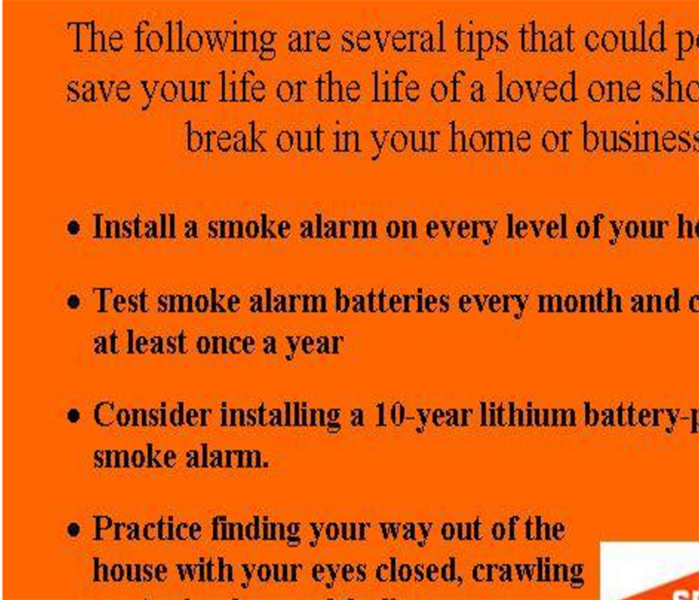 Fire Safety Plan
Fire Safety Plan
Fire Escape Planning is very important for each family and workplace. Be Prepared.






 24/7 Emergency Service
24/7 Emergency Service



















